Recent Progress in the Application of Coconut and Palm Oil Fibres in Cement-Based Materials
Abstract
:1. Introduction
2. Properties of Coconut and Palm Oil Fibres
2.1. Coconut Fibre
2.2. Oil Palm Fibre
3. Preparation and Pre-Treatment Methods for Coconut and Palm Oil Fibres
4. Mechanism of Natural Fibre as Reinforcement Material
5. Properties of Natural Fibre Cementitious Composite
5.1. Fresh State Properties
5.2. Hardened Concrete Properties
5.2.1. Mechanical Properties of Coconut Fibre Reinforced Cementitious Composites
5.2.2. Mechanical Properties of Palm Oil Fibre Reinforced Cementitious Composites
5.2.3. Durability Properties of Natural Fibre Reinforced Cementitious Composites
5.2.4. Thermal Properties Natural Fibre Reinforced Cementitious Composites
6. Conclusions
- (1)
- Coconut and palm oil fibres consist of approximately 33.2 to 65% cellulose, 11.6 to 33.5% hemicellulose and 13.2 to 45% lignin.
- (2)
- The bridging effect of natural fibres prevents the expansion of cracking of the cement matrix.
- (3)
- The most influencing factors of natural fibres on the mechanical properties of cement-based materials include the tensile strength of the natural fibre and the adhesion strength between the fibre and the cement matrix.
- (4)
- The pre-treatment of natural fibre, such as alkaline, silane and hot-water treatment, will remove impurities and silica particles from the surface of fibres and improve the adhesion strength between the natural fibre and the cement matrix.
- (5)
- Generally, natural fibres increase the mechanical properties of the cementitious composite. However, beyond a certain percentage, the mechanical properties dramatically decrease. This phenomenon occurs because natural fibres involve lots of air voids when mixed with a cement matrix, and these air voids cause strength reduction.
- (6)
- Natural fibres have high water absorption, and it would affect the workability of the fresh mixture negatively.
- (7)
- The incorporation of more natural fibre in the cementitious composite improves the thermal properties.
Author Contributions
Funding
Institutional Review Board Statement
Informed Consent Statement
Data Availability Statement
Acknowledgments
Conflicts of Interest
References
- Momoh, E.O.; Osofero, A.I. Behaviour of oil palm broom fibres (OPBF) reinforced concrete. Constr. Build. Mater. 2019, 221, 745–761. [Google Scholar] [CrossRef]
- Kobayakawa, S. Man-hour survey and analysis of the labor productivity of on-site work using the reinforced precast concrete frame method, survey and study of labor productivity of the reinforced precast concrete frame method (part 1). J. Archit. Plan. 2001, 66, 199–205. [Google Scholar] [CrossRef]
- Kunieda, M.; Uchida, Y.; Rokugou, K. Trends in the development of fibre reinforced cement composites; The properties of Materials Aiming for application that makes use of cement and concrete. Cem. Concr. 2007, 726, 7–12. [Google Scholar]
- Venkateshwaran, N.; Elayaperumal, A.; Sathiya, G.K. Prediction of tensile properties of hybrid-natural fiber composites. Compos. Part B Eng. 2012, 43, 793–796. [Google Scholar] [CrossRef]
- de Carvalho Bello, C.B.; Cecchi, A. Experiments on natural fibers: Durability and mechanical properties. Adv. Mater. Process. Technol. 2017, 3, 632–639. [Google Scholar] [CrossRef]
- Magdamo, R.V. An Analysis of the Abaca Natural Fiber in Reinforcing Concrete Composites as a Construction Material in Developing Countries; ProQuest Dissertations Publishing: Ann Arbor, MI, USA, 1988. [Google Scholar]
- Agustin, R.; Robles-Austriaco, L. Technological development of low cost materials in ASEAN countries. J. Ferrocem. 1990, 20, 265–279. [Google Scholar]
- The Editors of Encyclopaedia. “Natural Fibre”. Encyclopedia Britannica. 2020. Available online: https://www.britannica.com/topic/natural-fiber (accessed on 19 October 2021).
- Mase, K. Application of Bio-plastics to Automotive Parts. Senni Gakkai Shi 2008, 64, 276–278. [Google Scholar] [CrossRef]
- Daniyan, A.; Ogundare, O.; AttahDaniel, B.; Babatope, B. Effect of palm oil as corrosion inhibitor on ductile iron and mild steel. Pac. J. Sci. Technol. 2011, 12, 45–53. [Google Scholar]
- Chiew, Y.L.; Shimada, S. Current state and environmental impact assessment for utilizing oil palm empty fruit bunches for fuel, fiber and fertilizer—A case study of Malaysia. Biomass Bioenergy 2013, 51, 109–124. [Google Scholar] [CrossRef]
- Castro, J.; Naaman, A.E. Cement mortar reinforced with natural fibers. J. Ferrocem. 1981, 11, 285–301. [Google Scholar]
- Hashim, M.H.B.M. Coconut Fiber Reinforced Wall Panelling System. Unpublished Master’s Thesis, University of Technology Malaysia, Skudai, Johor, Malaysia, 2005. [Google Scholar]
- Brose, A.; Kongoletos, J.; Glicksman, L. Coconut fiber cement panels as wall insulation and structural diaphragm. Front. Energy Res. 2019, 7, 9. [Google Scholar] [CrossRef]
- Pan, H.; Liu, Y. Properties of natural fiber cement boards for building partitions. In Challenges, Opportunities and Solutions in Structural Engineering and Construction; CRC Press: Boca Raton, FL, USA, 2009; pp. 617–622. [Google Scholar]
- Li, Z.; Wang, L.; Wang, X.A. Cement Composites Reinforced with Surface Modified Coir Fibers. J. Compos. Mater. 2007, 41, 1445–1457. [Google Scholar] [CrossRef]
- Ali, M. Coconut fibre: A versatile material and its applications in engineering. J. Civ. Eng. Constr. Technol. 2011, 2, 189–197. [Google Scholar]
- Embrandiri, A.; Singh, R.P.; Ibrahim, H.M.; Ramli, A.A. Land application of biomass residue generated from palm oil processing: Its potential benefits and threats. Environmentalist 2012, 32, 111–117. [Google Scholar] [CrossRef]
- Quiñones-Bolaños, E.; Gómez-Oviedo, M.; Mouthon-Bello, J.; Sierra-Vitola, L.; Berardi, U.; Bustillo-Lecompte, C. Potential use of coconut fibre modified mortars to enhance thermal comfort in low-income housing. J. Environ. Manag. 2021, 277, 111503. [Google Scholar] [CrossRef] [PubMed]
- Bui, H.; Sebaibi, N.; Boutouil, M.; Levacher, D. Determination and Review of Physical and Mechanical Properties of Raw and Treated Coconut Fibers for Their Recycling in Construction Materials. Fibers 2020, 8, 37. [Google Scholar] [CrossRef]
- Ardanuy, M.; Claramunt, J.; Toledo Filho, R.D. Cellulosic fiber reinforced cement-based composites: A review of recent research. Constr. Build. Mater. 2015, 79, 115–128. [Google Scholar] [CrossRef]
- Ahmad, Z.; Saman, H.; Tahir, P. Oil Palm Trunk Fiber as a Bio-Waste Resource for Concrete Reinforcement. Int. J. Mech. Mater. Eng. 2010, 5, 199–207. [Google Scholar]
- Bonnet-Masimbert, P.-A.; Gauvin, F.; Brouwers, H.; Amziane, S. Study of modifications on the chemical and mechanical compatibility between cement matrix and oil palm fibres. Results Eng. 2020, 7, 100150. [Google Scholar] [CrossRef]
- Ozerkan, N.G.; Ahsan, B.; Mansour, S.; Iyengar, S.R. Mechanical performance and durability of treated palm fiber reinforced mortars. Int. J. Sustain. Built Environ. 2013, 2, 131–142. [Google Scholar] [CrossRef]
- Ferdiansyah, T.; Razak, H.A. Mechanical properties of black sugar palm fiber-reinforced concrete. J. Reinf. Plast. Compos. 2011, 30, 994–1004. [Google Scholar] [CrossRef]
- Rasoul, Z.S.; Juoi, J.M.; Mohamad, M.; Fawzi, N.M. Date Palm Fiber (DPF) and its Composites: A Comprehensive Survey. Int. J. Adv. Sci. Technol. 2020, 29, 1776–1788. [Google Scholar]
- Olaoye, R.; Oluremi, J.; Ajamu, S. The use of fibre waste as complement in concrete for a sustainable environment. Innov. Syst. Des. Eng. 2013, 4, 91–98. [Google Scholar]
- Hwang, C.-L.; Tran, V.-A.; Hong, J.-W.; Hsieh, Y.-C. Effects of short coconut fiber on the mechanical properties, plastic cracking behavior, and impact resistance of cementitious composites. Constr. Build. Mater. 2016, 127, 984–992. [Google Scholar] [CrossRef]
- Momoh, E.O.; Osofero, A.I. Recent developments in the application of oil palm fibers in cement composites. Front. Struct. Civ. Eng. 2020, 14, 94–108. [Google Scholar] [CrossRef]
- Rachedi, M.; Kriker, A. Thermal Properties of Plaster Reinforced with Date Palm Fibers. Civ. Environ. Eng. 2020, 16, 259–266. [Google Scholar] [CrossRef]
- Shafigh, P.; Asadi, I.; Akhiani, A.R.; Mahyuddin, N.B.; Hashemi, M. Thermal properties of cement mortar with different mix proportions. Mater. De Construcción 2020, 70, 224. [Google Scholar] [CrossRef]
- Ramakrishna, G.; Sundararajan, T. Impact strength of a few natural fibre reinforced cement mortar slabs: A comparative study. Cem. Concr. Compos. 2005, 27, 547–553. [Google Scholar] [CrossRef]
- John, V.; Cincotto, M.; Sjöström, C.; Agopyan, V.; Oliveira, C. Durability of slag mortar reinforced with coconut fibre. Cem. Concr. Compos. 2005, 27, 565–574. [Google Scholar] [CrossRef]
- Hill, C.A.; Khalil, H.A.; Hale, M.D. A study of the potential of acetylation to improve the properties of plant fibres. Ind. Crop. Prod. 1998, 8, 53–63. [Google Scholar] [CrossRef]
- Ngadiman, N.; Kaamin, M.; Kadir, A.A.; Sahat, S.; Zaini, A.; Zentan, S.R.N.; Ahmad, N.A.; Amran, W.H.A.W. Panel board from coconut fibre and pet bottle. In Proceedings of the E3S Web of Conferences, Johor, Malaysia, 19 March 2018; p. 01014. [Google Scholar]
- Ramakrishna, G.; Sundararajan, T. Studies on the durability of natural fibres and the effect of corroded fibres on the strength of mortar. Cem. Concr. Compos. 2005, 27, 575–582. [Google Scholar] [CrossRef]
- Femandez, J. Flax fiber reinforced concrete-a natura1 fiber biocomposite for sustainable building materials. WIT Trans. Built Environ. 2002, 59, 15. [Google Scholar] [CrossRef]
- Rao, K.M.M.; Rao, K.M. Extraction and tensile properties of natural fibers: Vakka, date and bamboo. Compos. Struct. 2007, 77, 288–295. [Google Scholar] [CrossRef]
- Ramli, M.; Kwan, W.H.; Abas, N.F. Strength and durability of coconut-fiber-reinforced concrete in aggressive environments. Constr. Build. Mater. 2013, 38, 554–566. [Google Scholar] [CrossRef]
- Agopyan, V.; Savastano, H., Jr.; John, V.; Cincotto, M. Developments on vegetable fibre–cement based materials in São Paulo, Brazil: An overview. Cem. Concr. Compos. 2005, 27, 527–536. [Google Scholar] [CrossRef]
- Khalil, H.A.; Hanida, S.; Kang, C.; Fuaad, N.N. Agro-hybrid composite: The effects on mechanical and physical properties of oil palm fiber (EFB)/glass hybrid reinforced polyester composites. J. Reinf. Plast. Compos. 2007, 26, 203–218. [Google Scholar] [CrossRef]
- Lertwattanaruk, P.; Suntijitto, A. Properties of natural fiber cement materials containing coconut coir and oil palm fibers for residential building applications. Constr. Build. Mater. 2015, 94, 664–669. [Google Scholar] [CrossRef]
- Raut, A.N.; Gomez, C.P. Thermal and mechanical performance of oil palm fiber reinforced mortar utilizing palm oil fly ash as a complementary binder. Constr. Build. Mater. 2016, 126, 476–483. [Google Scholar]
- Ahmad, M.H.; Mohd Noor, N. Mix design of palm oil fiber concrete. In Proceedings of the International Conference on Civil Engineering, Pahang, Malaysia, 12–14 May 2008. [Google Scholar]
- Ahmad, Z.; Ibrahim, A.; Tahir, P. Drying shrinkage characteristics of concrete reinforced with oil palm trunk fiber. Int. J. Eng. Sci. Technol. 2010, 2, 1441–1450. [Google Scholar]
- Abdullah, A.; Abdullah, M.M.A.B.; Kamarudin, H.; Ghazali, C.M.R.; Salleh, M.A.A.M.; Sang, P.K.; Muhammad Faheem, M.T. Study on the properties of oil palm trunk fiber (OPTF) in cement composite. Appl. Mech. Mater. 2013, 421, 395–400. [Google Scholar] [CrossRef]
- Yan, Y. 2-Developments in fibers for technical nonwovens. In Advances in Technical Nonwovens; Kellie, G., Ed.; Woodhead Publishing: Sawston, UK, 2016; pp. 19–96. [Google Scholar]
- Momoh, E.O.; Osofero, A.I.; Menshykov, O. Physicomechanical Properties of Treated Oil Palm-Broom Fibers for Cementitious Composites. J. Mater. Civ. Eng. 2020, 32, 04020300. [Google Scholar] [CrossRef]
- Abdullah, A. Composite Cement Reinforced Coconut Fiber: Physical and Mechanical Properties and Fracture Behavior. Aust. J. Basic Appl. Sci. 2011, 5, 1228–1240. [Google Scholar]
- Neville, A.M. Properties of Concrete, 5th ed.; Longman: London, UK, 2011. [Google Scholar]
- Naamandadin, N.A.; Rosdi, M.S.; Mustafa, W.A.; Shahrol Aman, M.N.S.; Saidi, S.A. Mechanical behaviour on concrete of coconut coir fiber as additive. IOP Conf. Ser. Mater. Sci. Eng. 2020, 932, 012098. [Google Scholar] [CrossRef]
- Ramli, M.S.; Abas, N.F.; Othuman Mydin, M.A. Investigation of Mechanical Properties of Coconut Fiber as a Concrete Admixture. MATEC Web Conf. 2014, 17, 01018. [Google Scholar] [CrossRef]
- Sathiparan, N.; Rupasinghe, M.N.; H.M. Pavithra, B. Performance of coconut coir reinforced hydraulic cement mortar for surface plastering application. Constr. Build. Mater. 2017, 142, 23–30. [Google Scholar] [CrossRef]
- Shfafi, S.M.S.M. Effect of Coconut Fibre in Concrete and to Improve the Workability by Incorporating an Admixture. Engineering. 2016. Available online: https://www.slideshare.net/HSAAMHSAAM/effect-of-coconut-fibre-in-concrete-and-to-improve-the (accessed on 19 October 2021).
- Khoudja, D.; Taallah, B.; Izemmouren, O.; Aggoun, S.; Herihiri, O.; Guettala, A. Mechanical and thermophysical properties of raw earth bricks incorporating date palm waste. Constr. Build. Mater. 2021, 270, 121824. [Google Scholar] [CrossRef]
- Lee, S.W.; Oh, C.L.; Zain, M.R.M.; Yahya, N.A. The Use of Oil Palm Fiber as Additive Material in Concrete. IOP Conf. Ser. Mater. Sci. Eng. 2018, 431, 042012. [Google Scholar] [CrossRef]
- Ramli, M.; Dawood, E.T. Effects of palm fiber on the mechanical properties of lightweight concrete crushed brick. Am. J. Appl. Sci. 2011, 3, 489–493. [Google Scholar] [CrossRef]
- Benmansour, N.; Agoudjil, B.; Gherabli, A.; Kareche, A.; Boudenne, A. Thermal and mechanical performance of natural mortar reinforced with date palm fibers for use as insulating materials in building. Energy Build. 2014, 81, 98–104. [Google Scholar] [CrossRef]
- Tioua, T.; Kriker, A.; Salhi, A.; Barluenga, G. Effect of Hot-Dry Environment on Fiber-Reinforced Self-Compacting Concrete; AIP Publishing: College Park, MD, USA, 2016. [Google Scholar] [CrossRef]
- Suhaili, S.S.; Mydin, M.A.O.; Awang, H. Influence of Mesocarp Fibre Inclusion on Thermal Properties of Foamed Concrete. J. Adv. Res. Fluid Mech. Therm. Sci. 2021, 8, 1–11. [Google Scholar] [CrossRef]
- Awang, H.; Ahmad, M.H. Durability properties of foamed concrete with fiber inclusion. World Acad. Sci. Eng. Technol. Int. J. Civ. Environ. Struct. Constr. Archit. Eng. 2014, 8, 269–272. [Google Scholar]

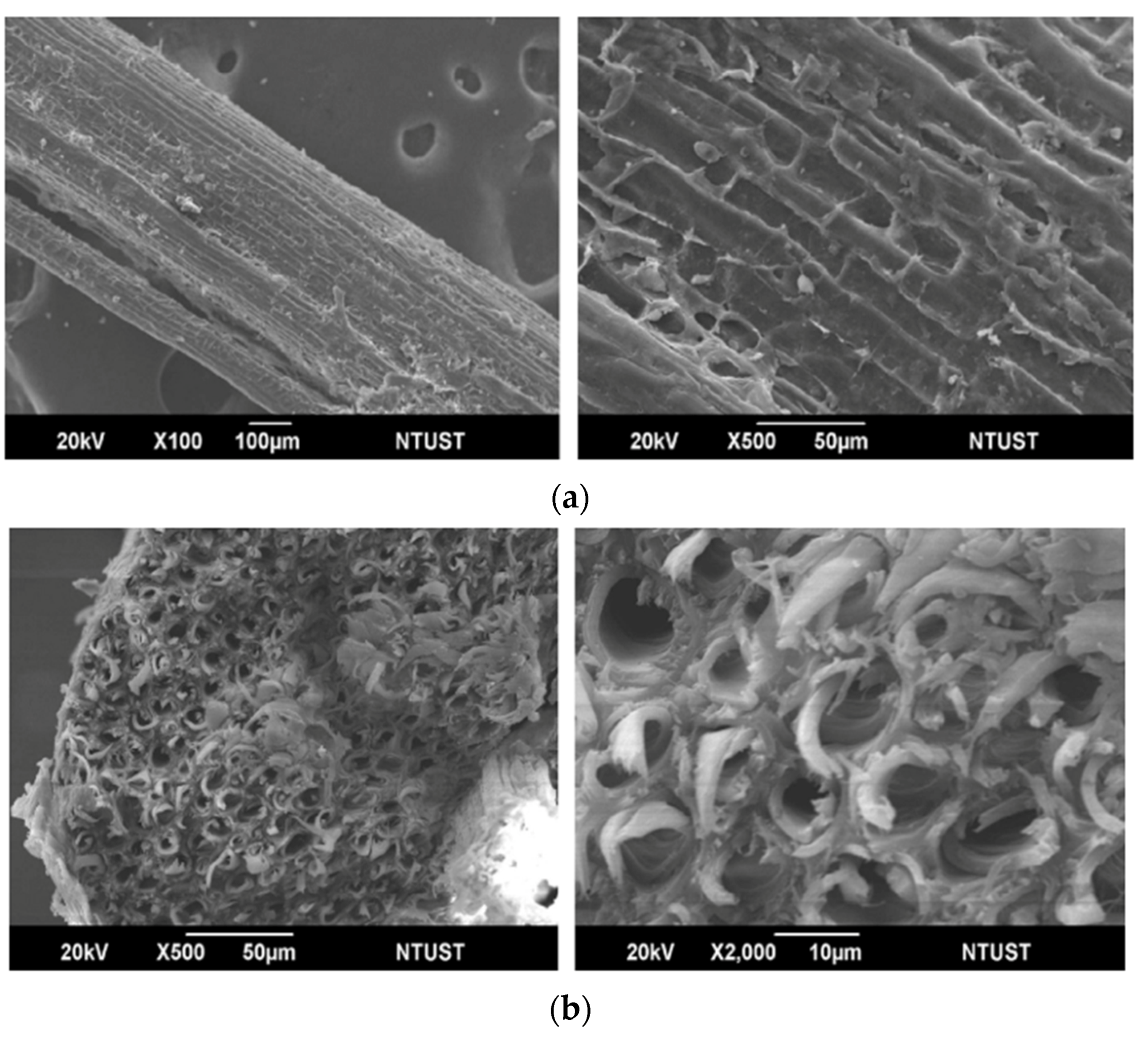



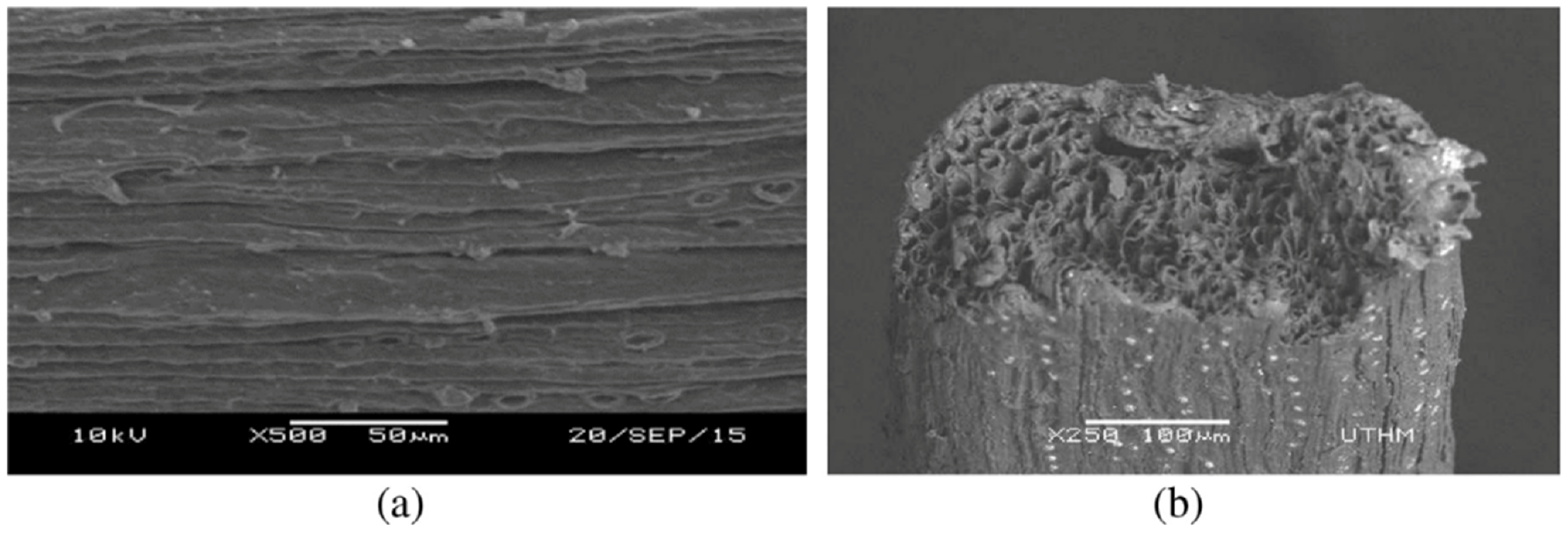
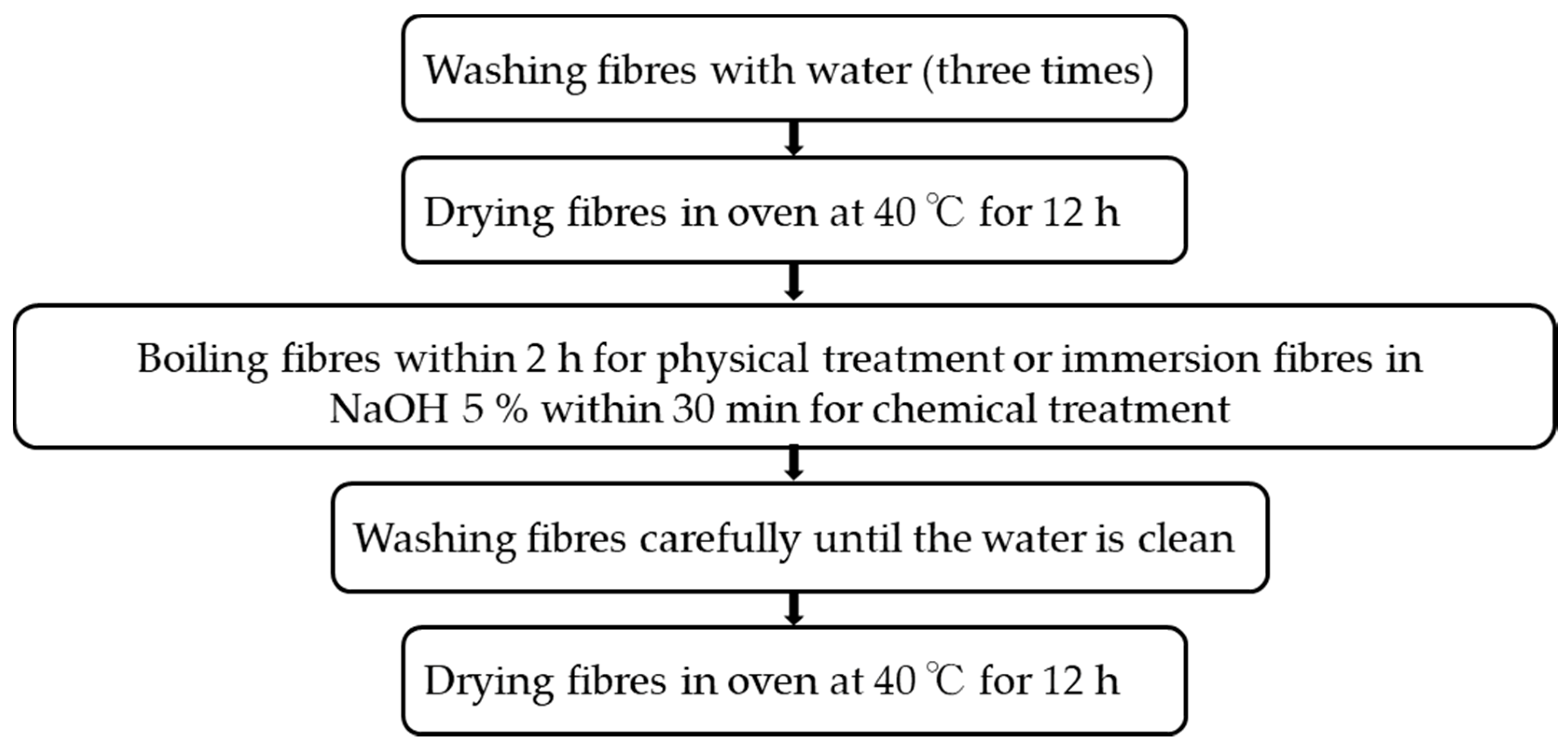
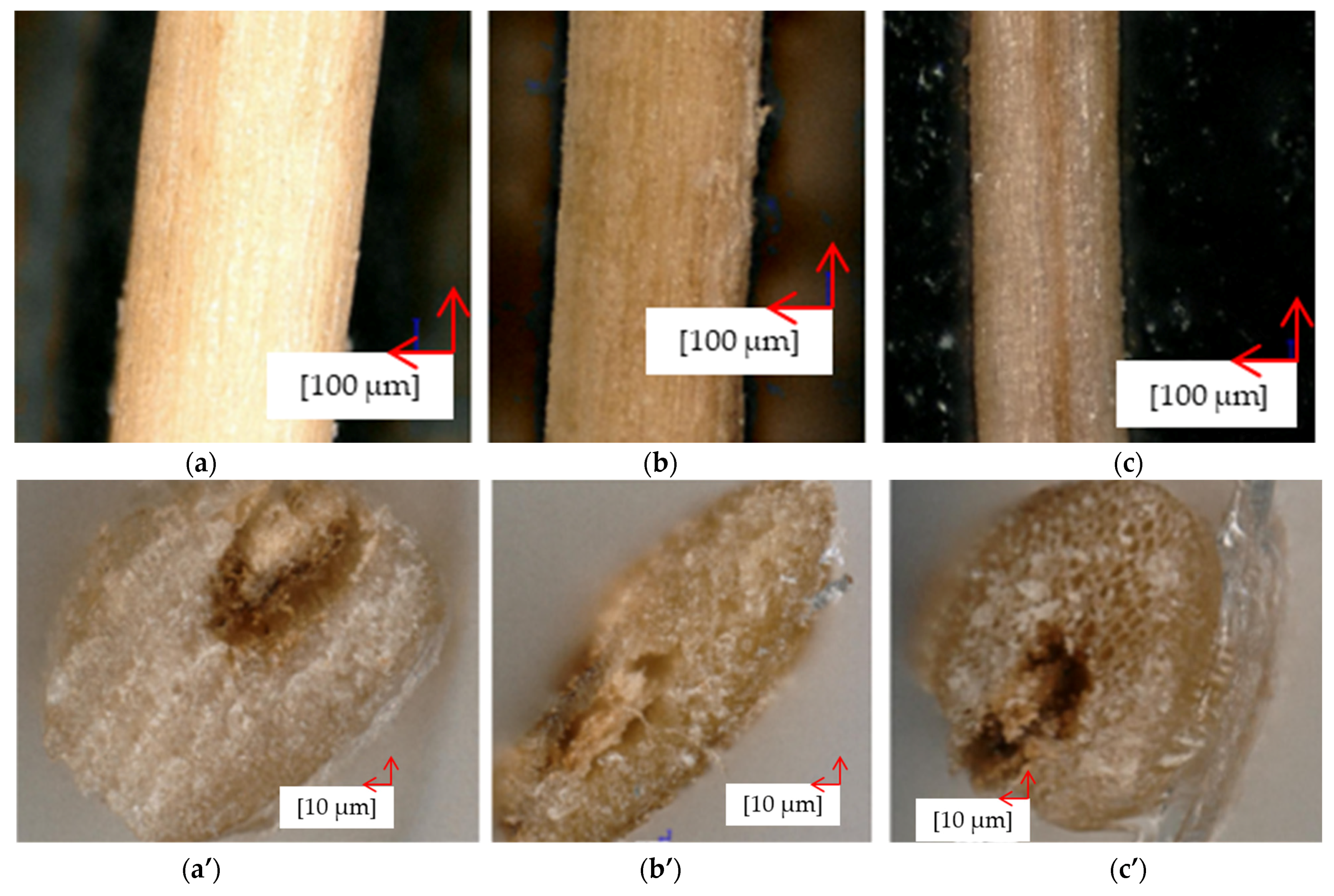
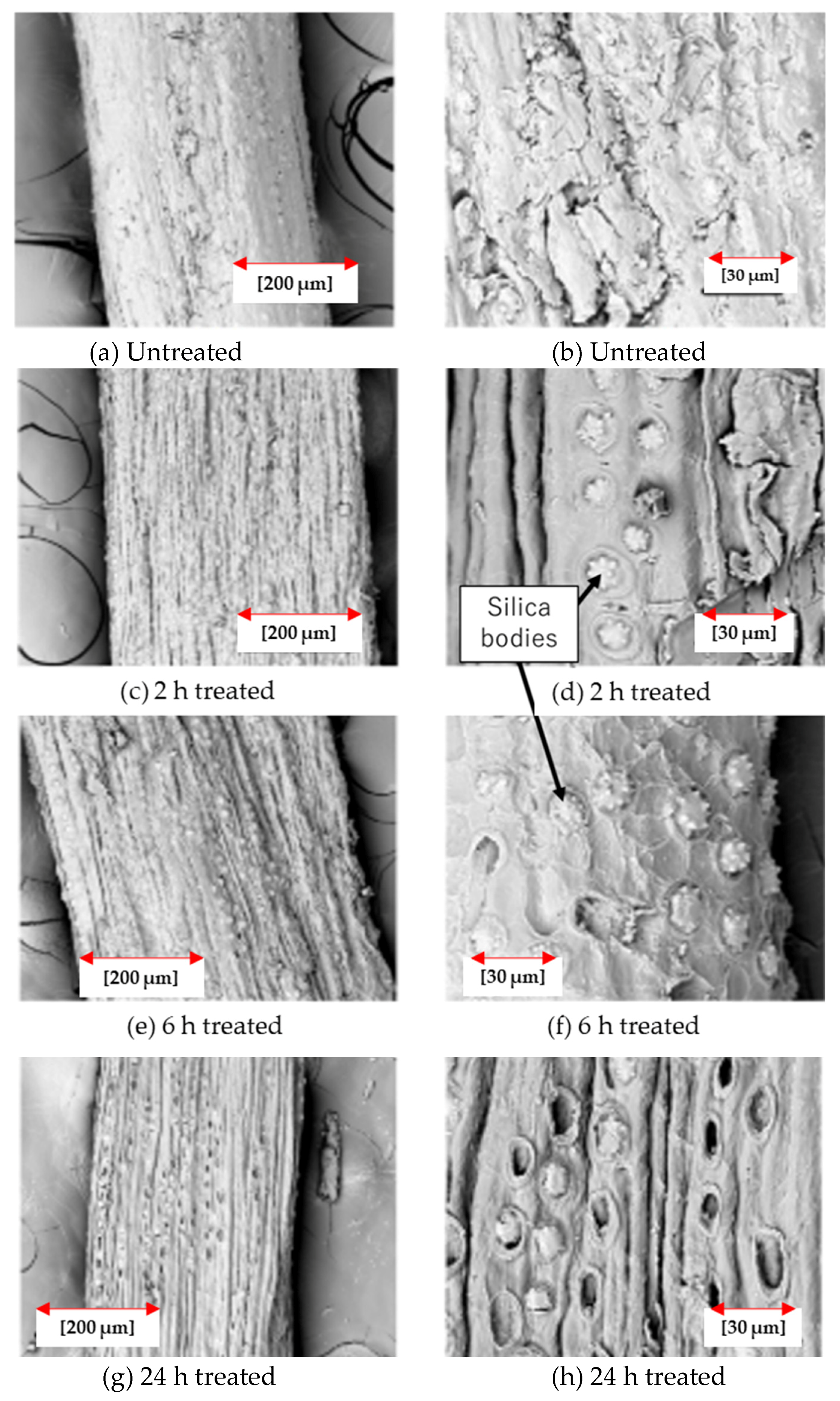

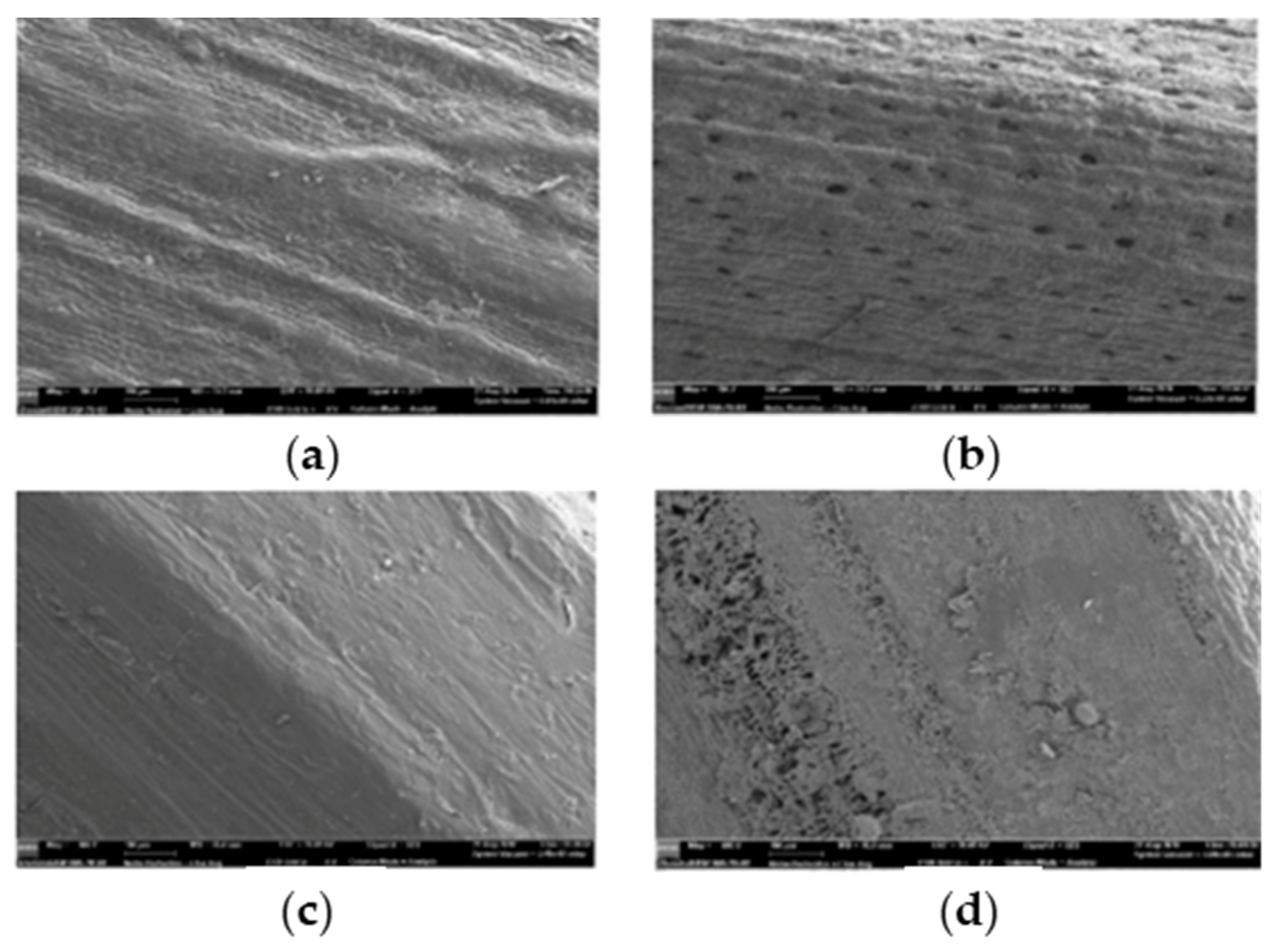
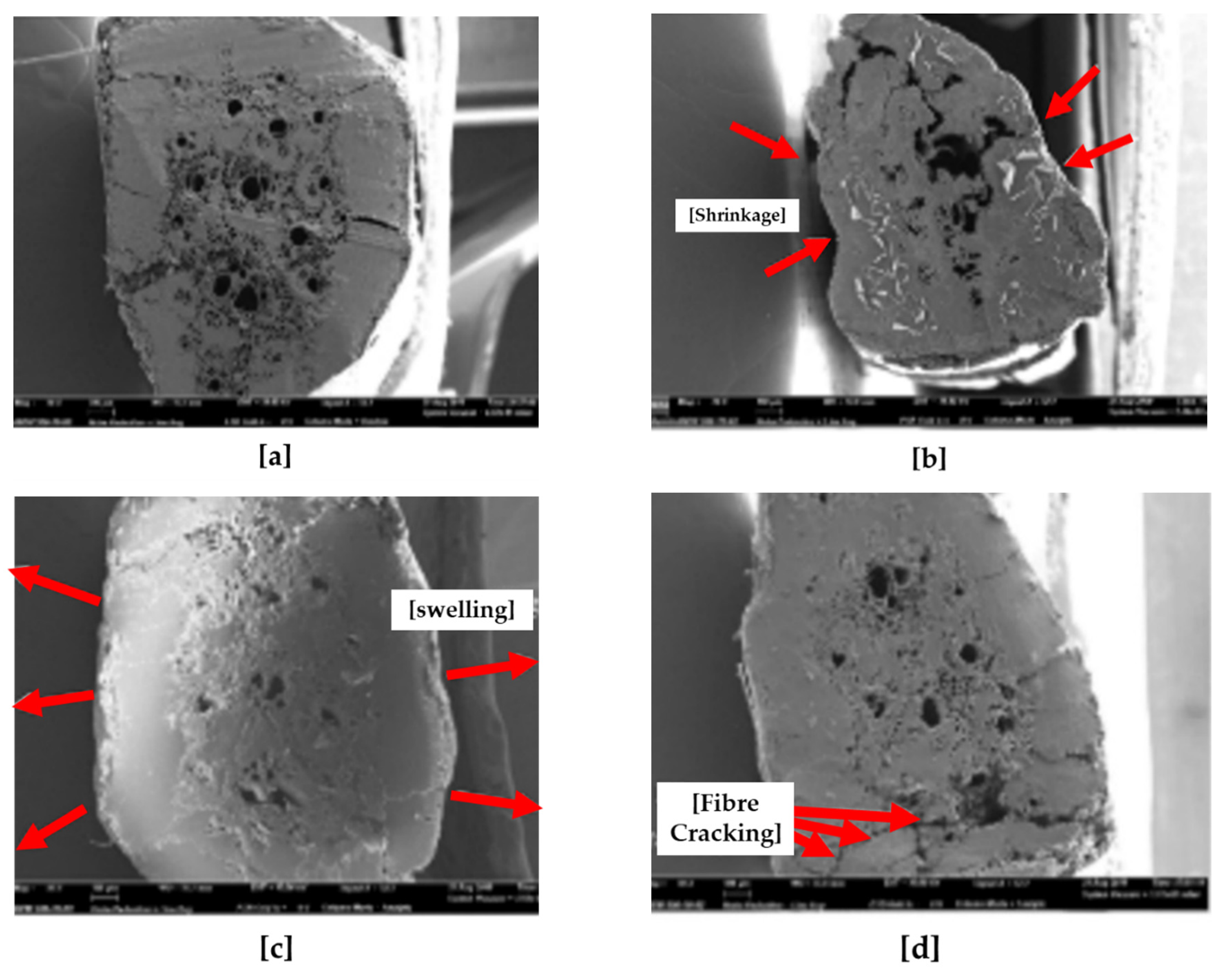
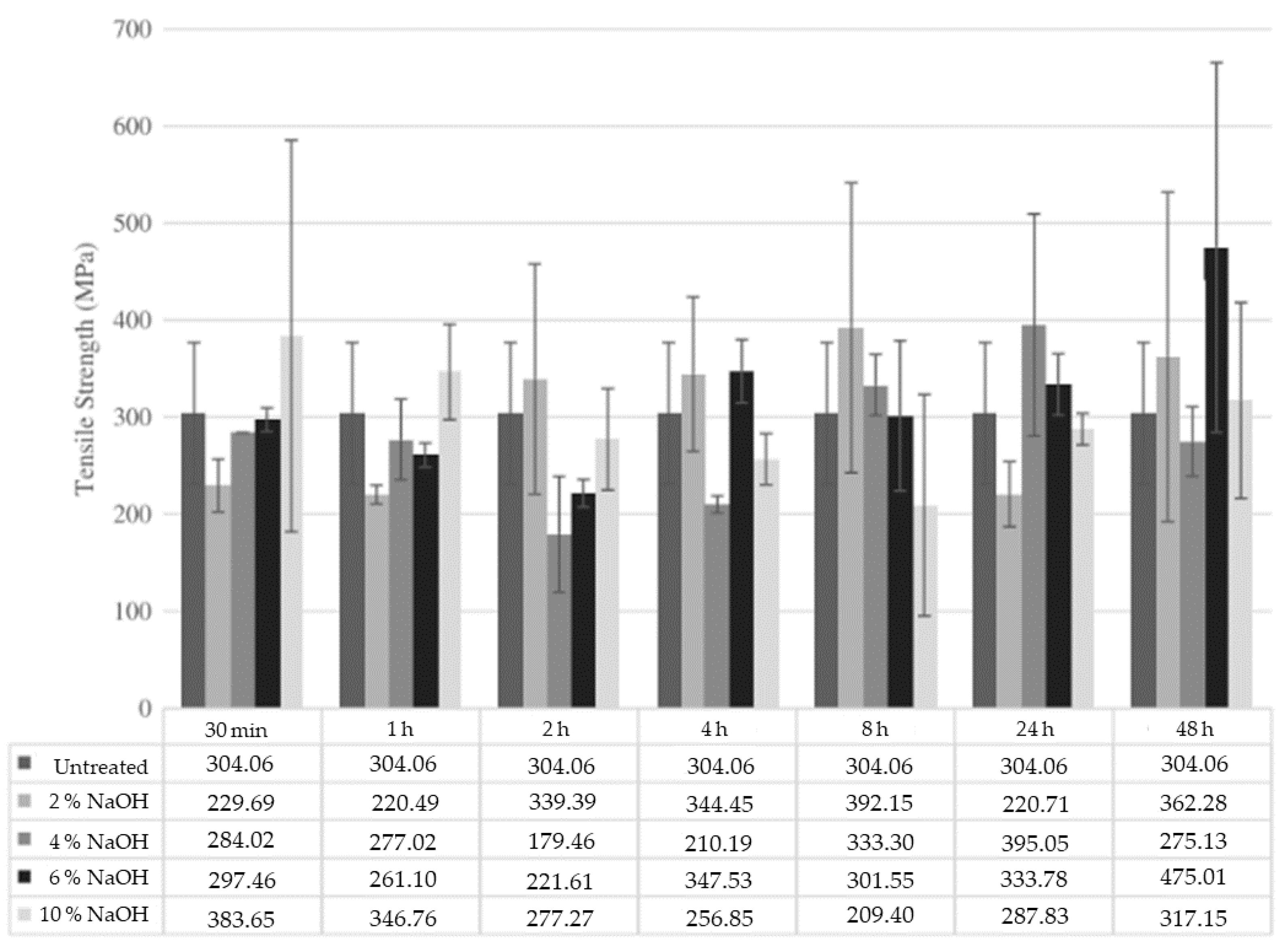
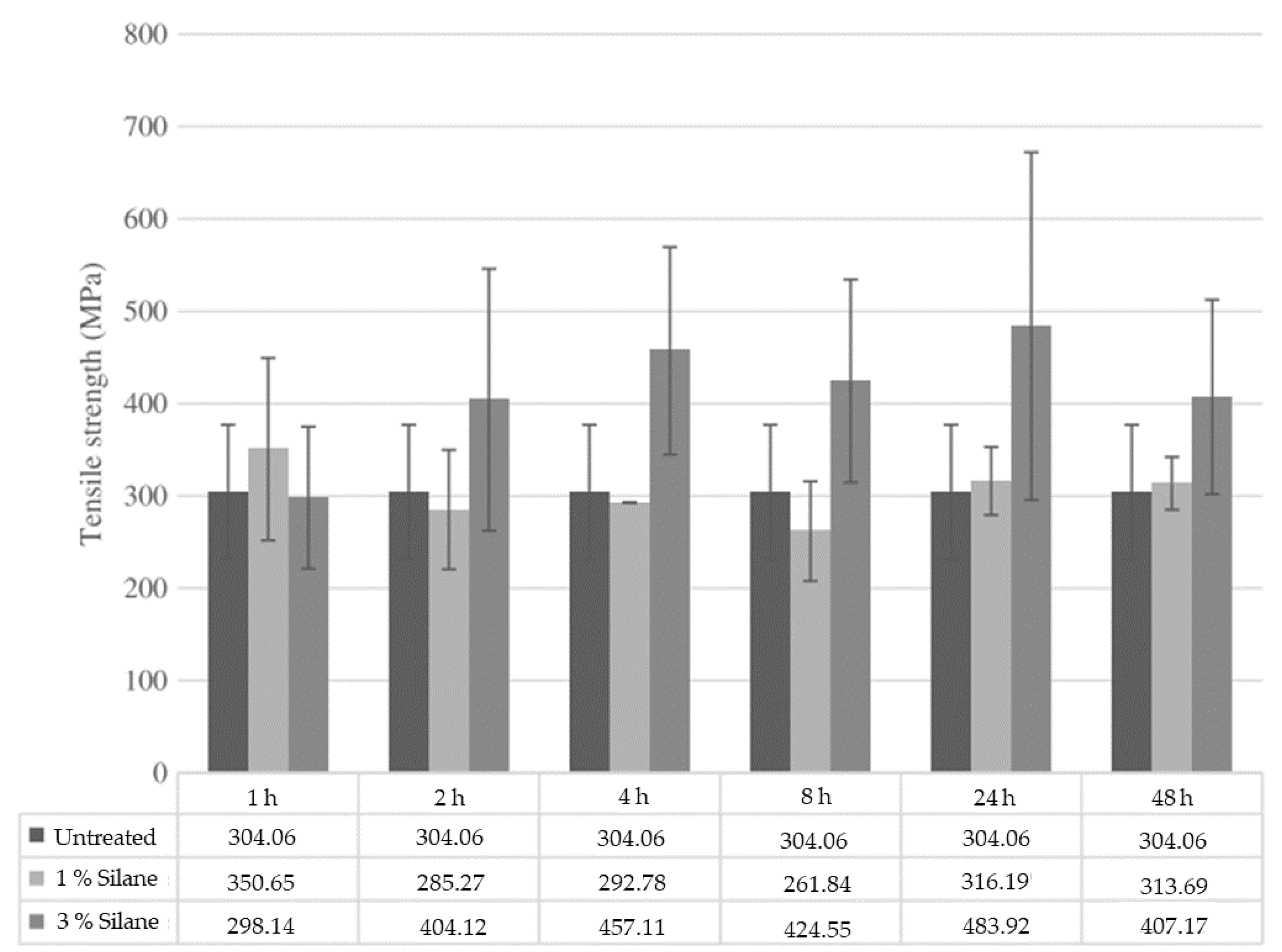
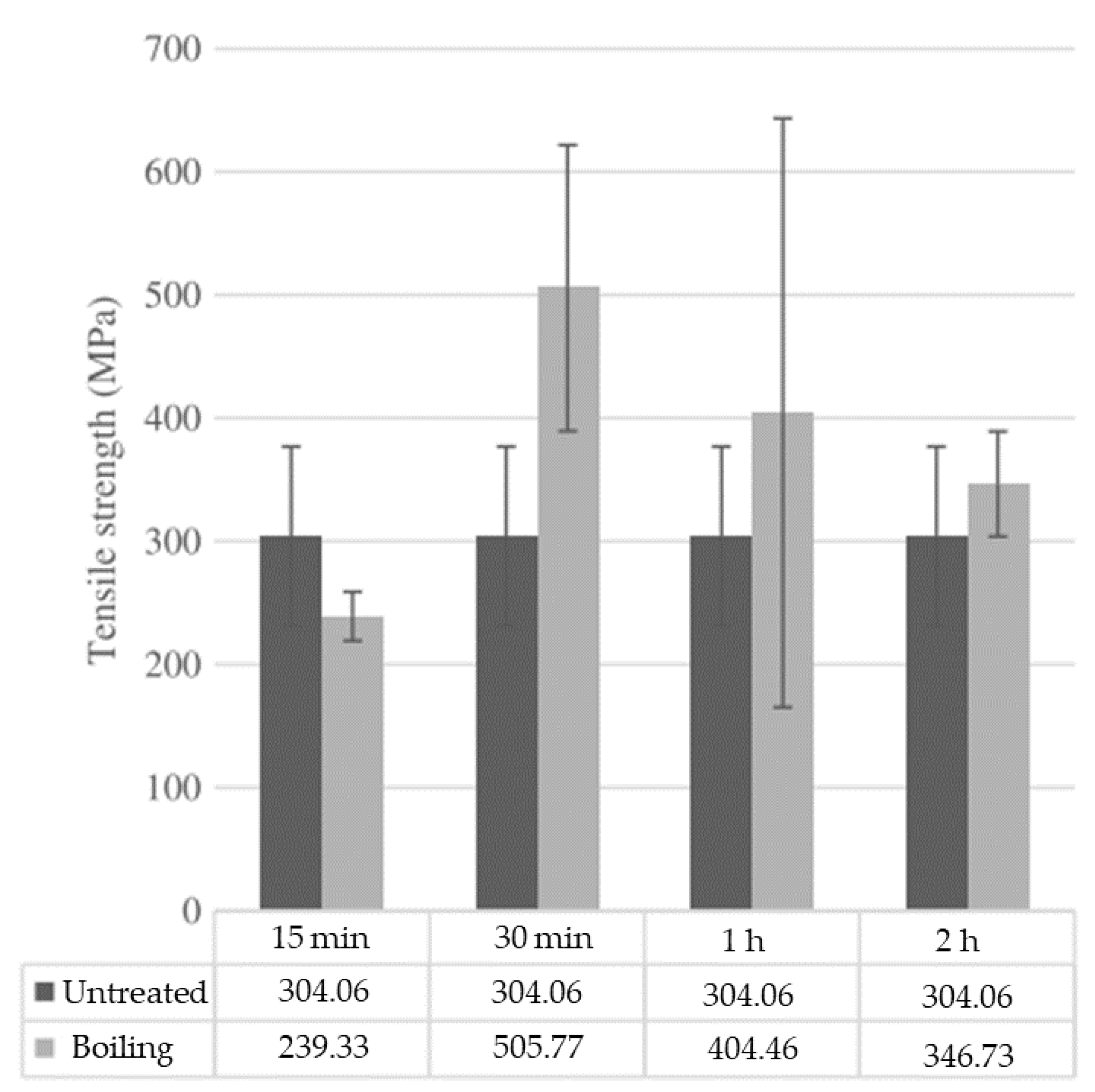
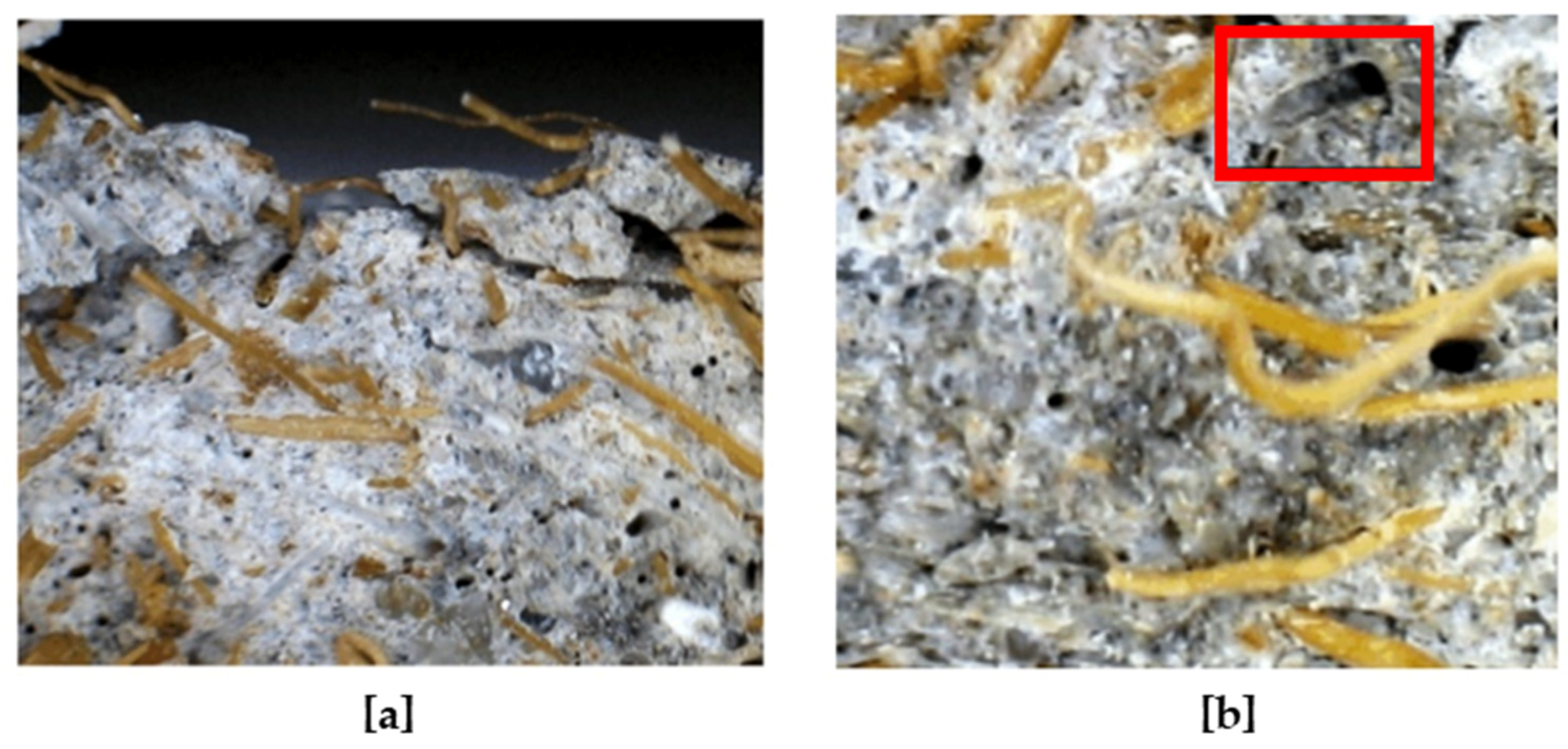
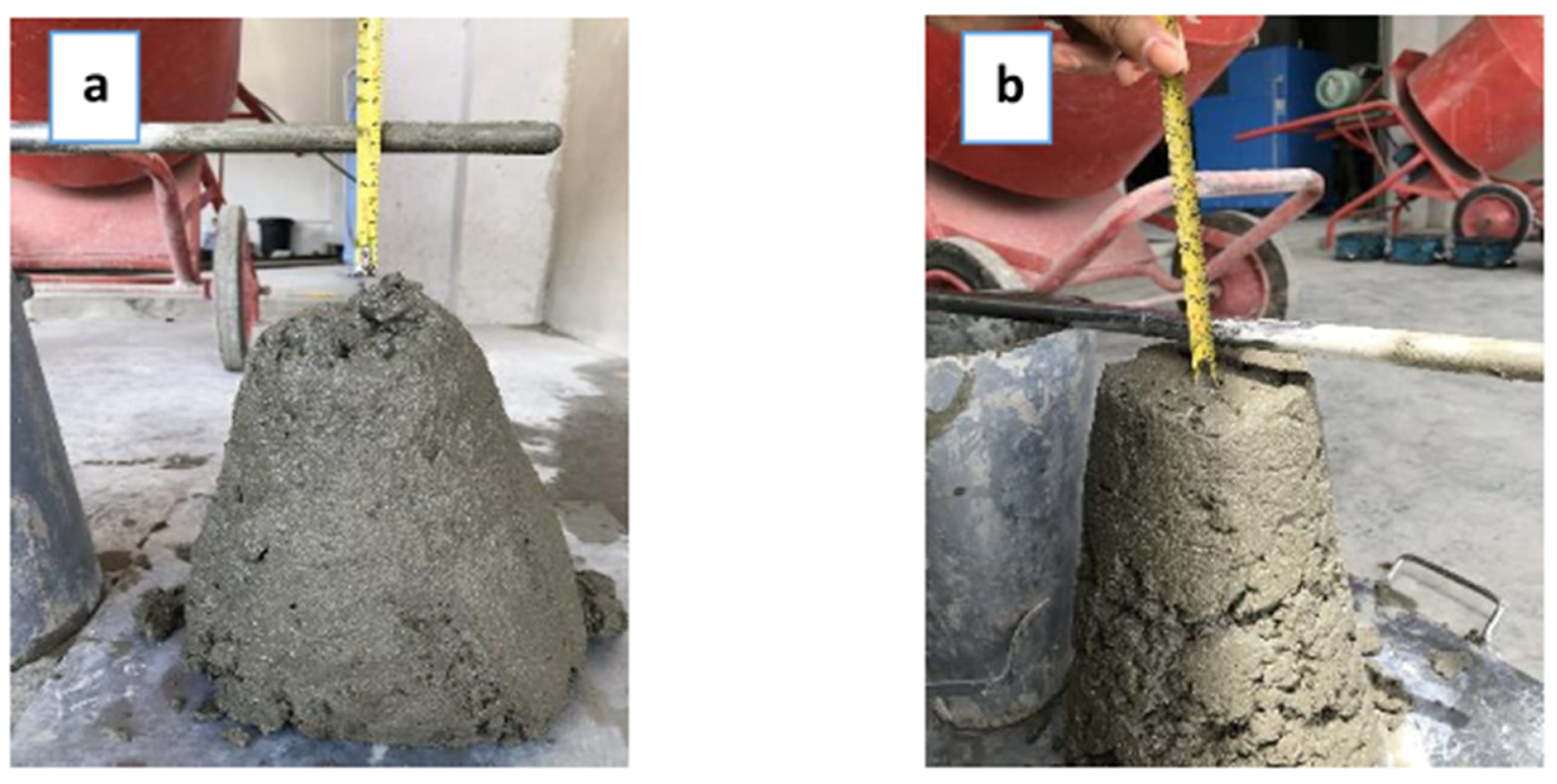
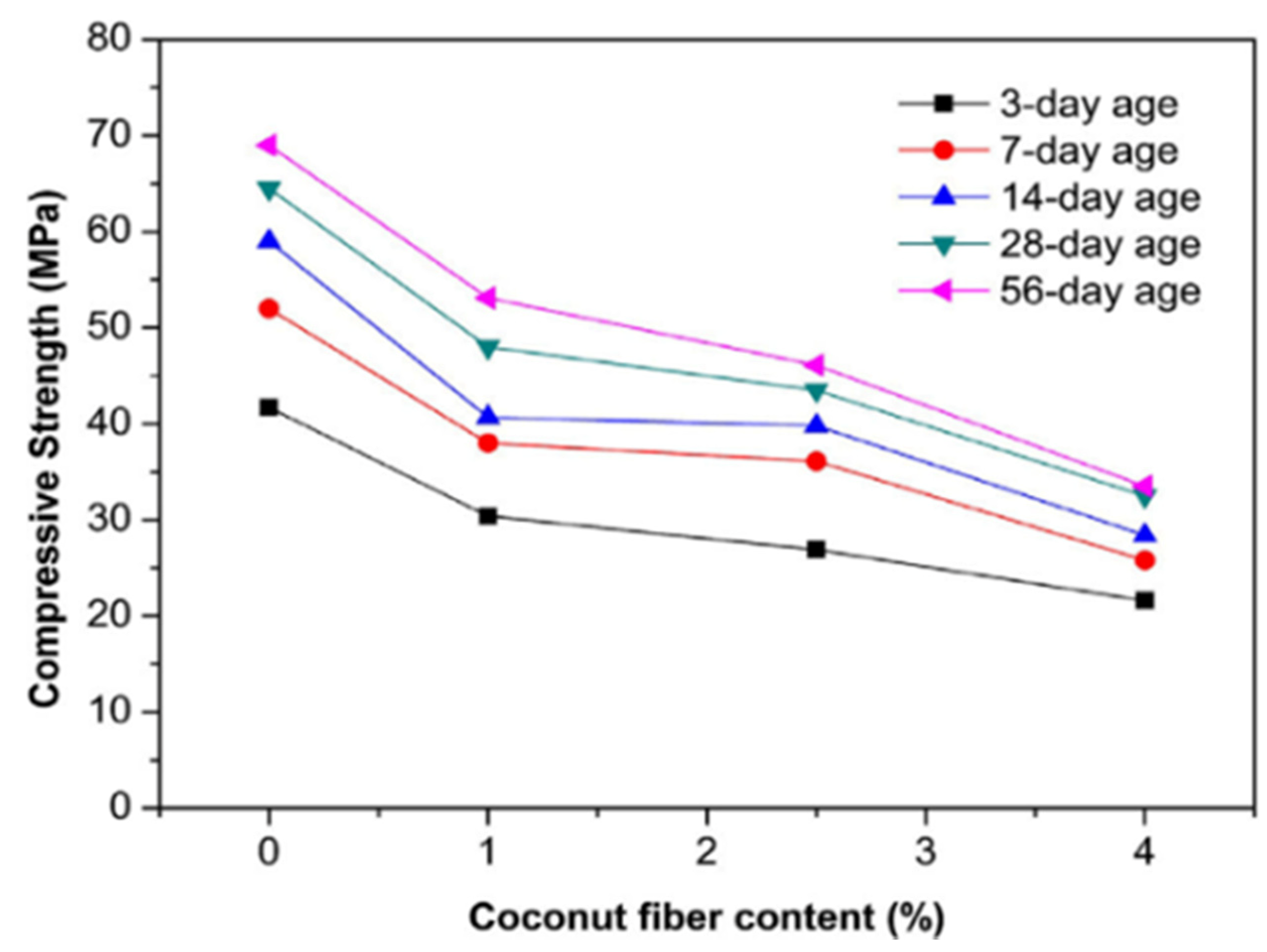
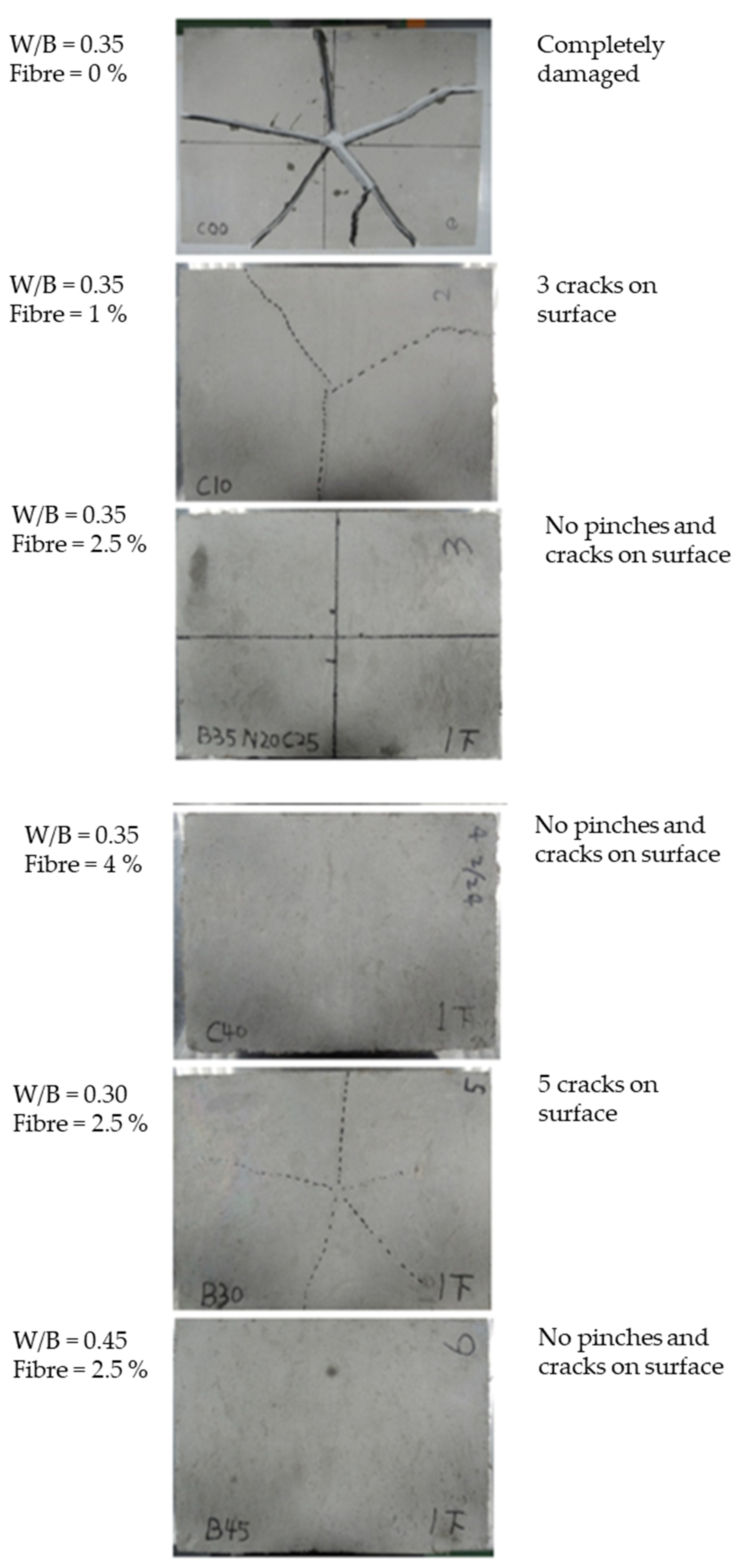
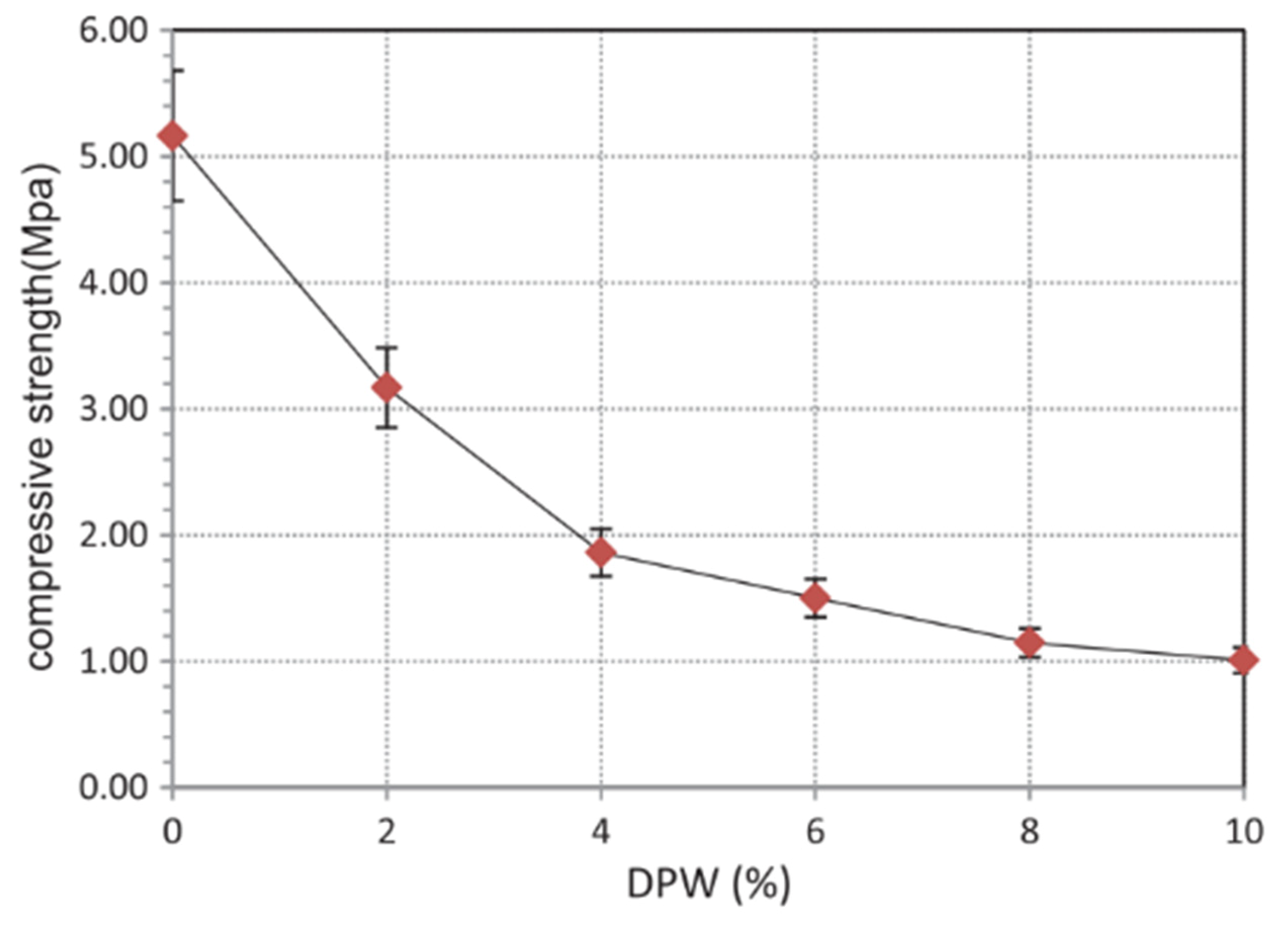
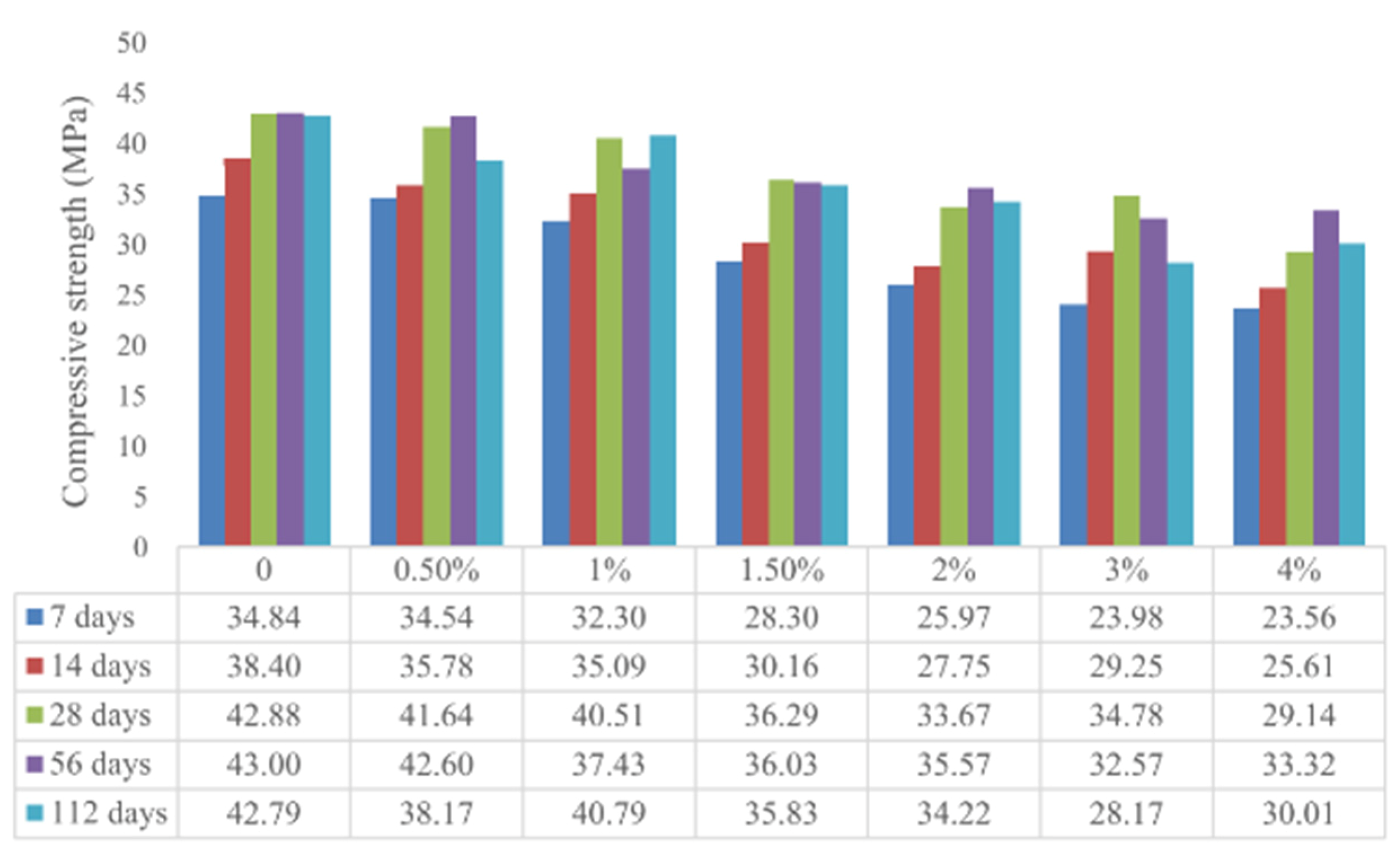
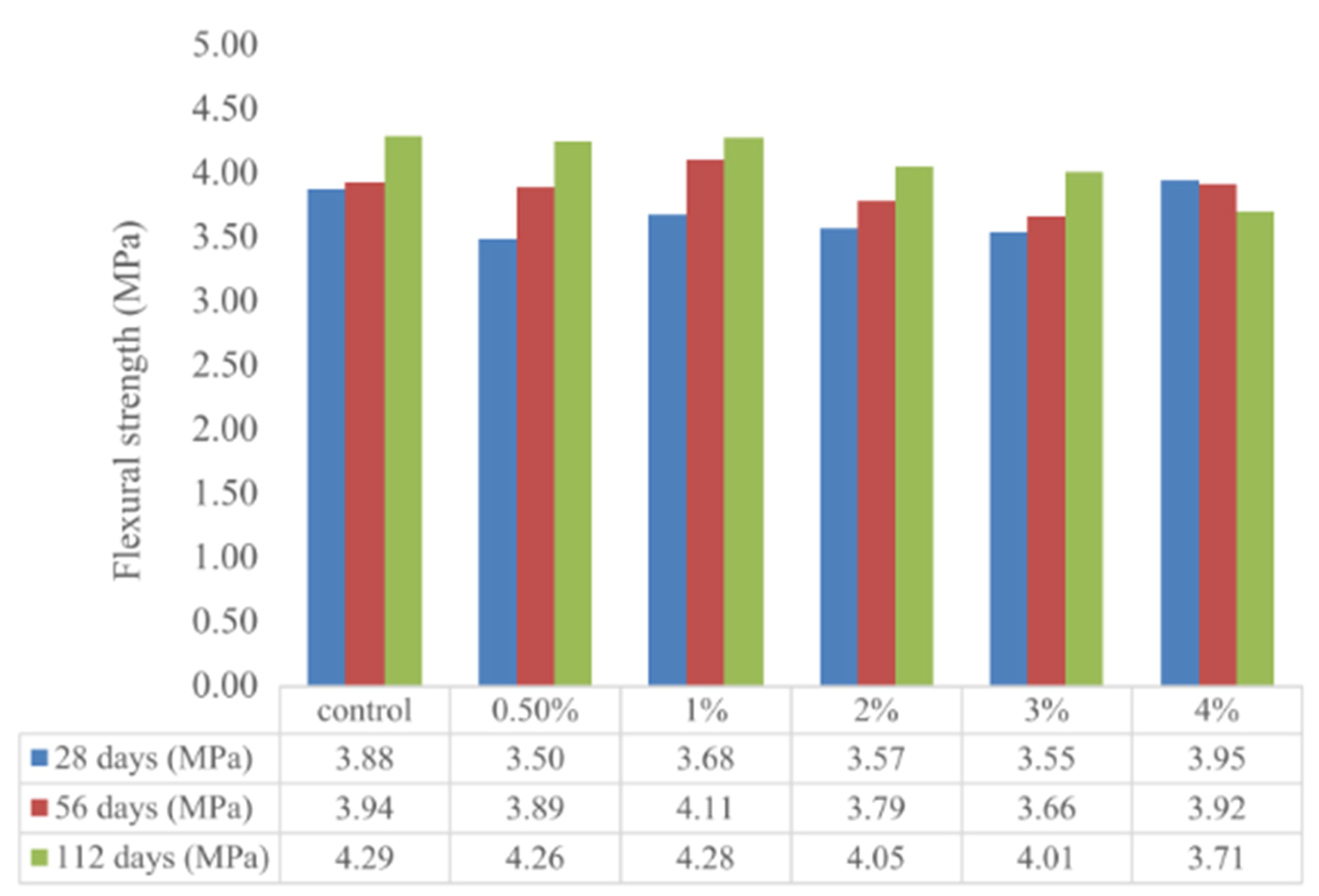
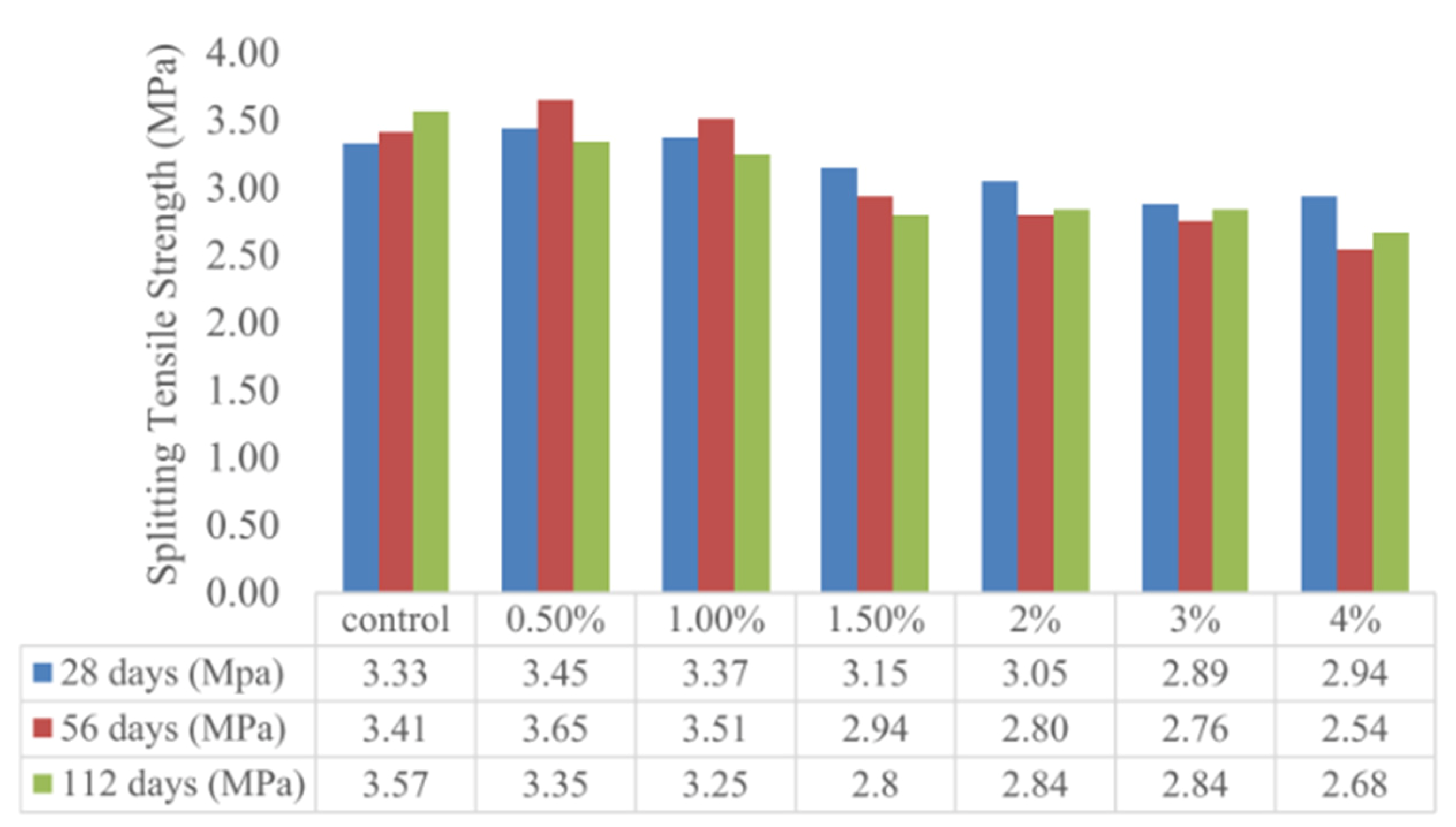
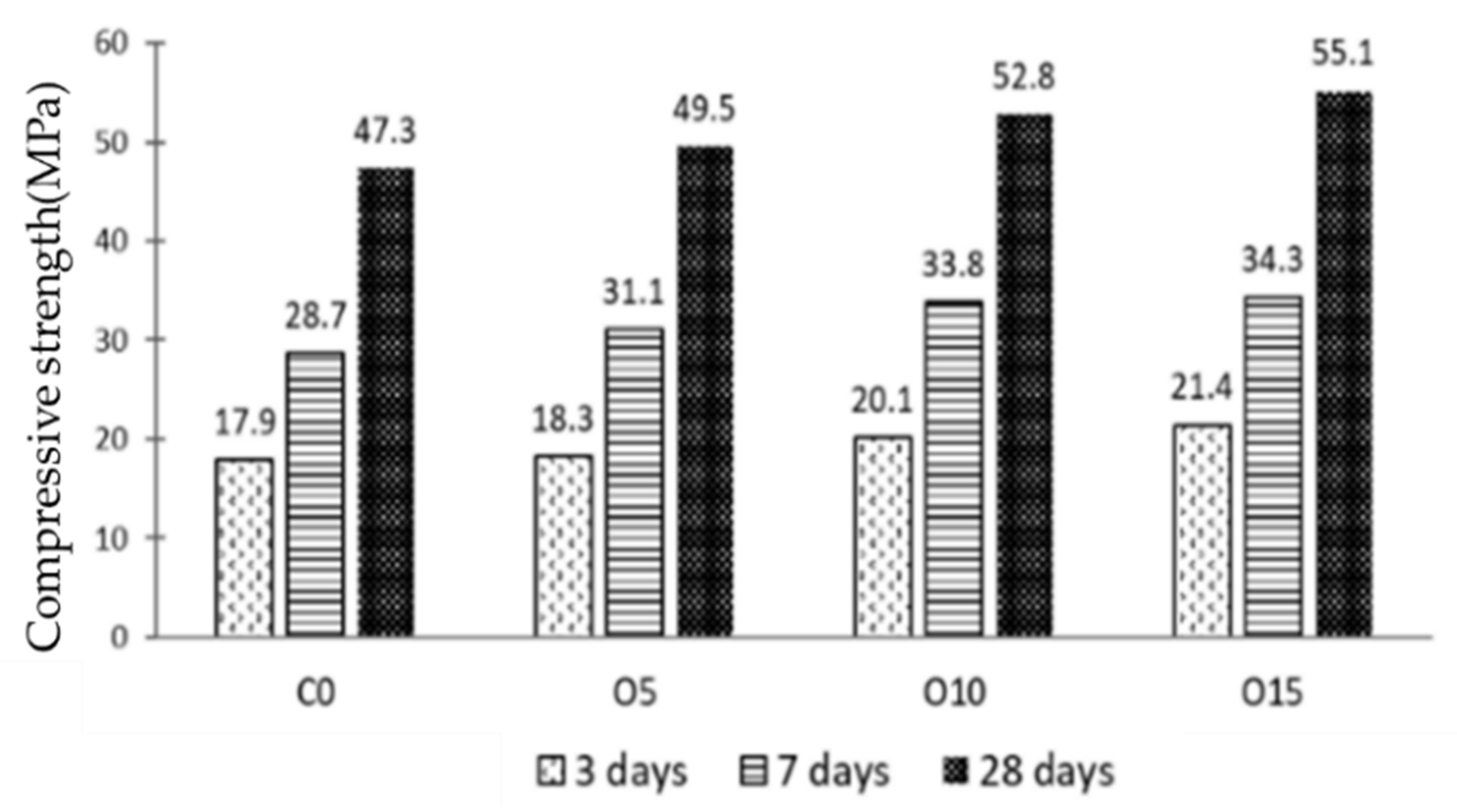
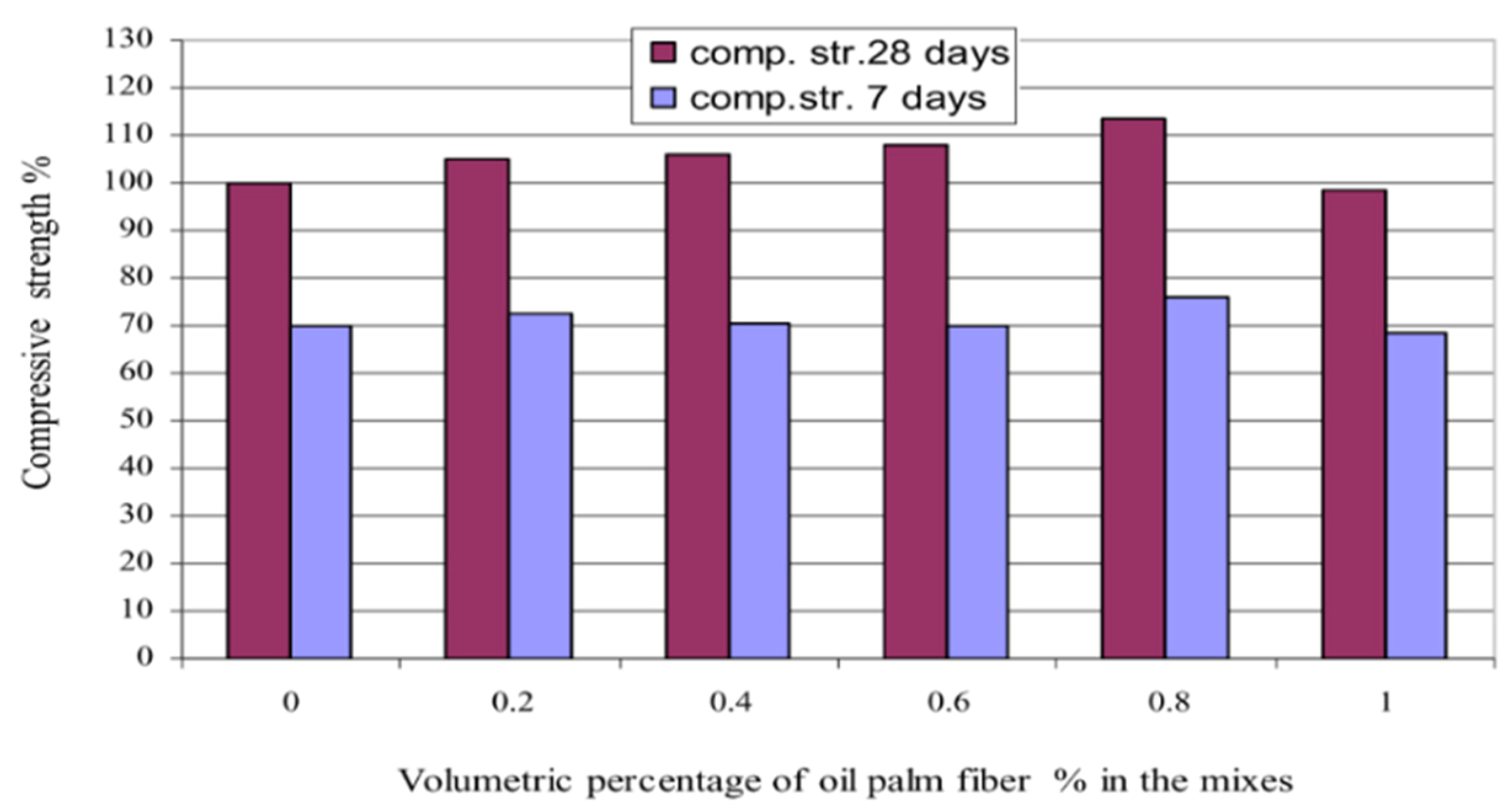
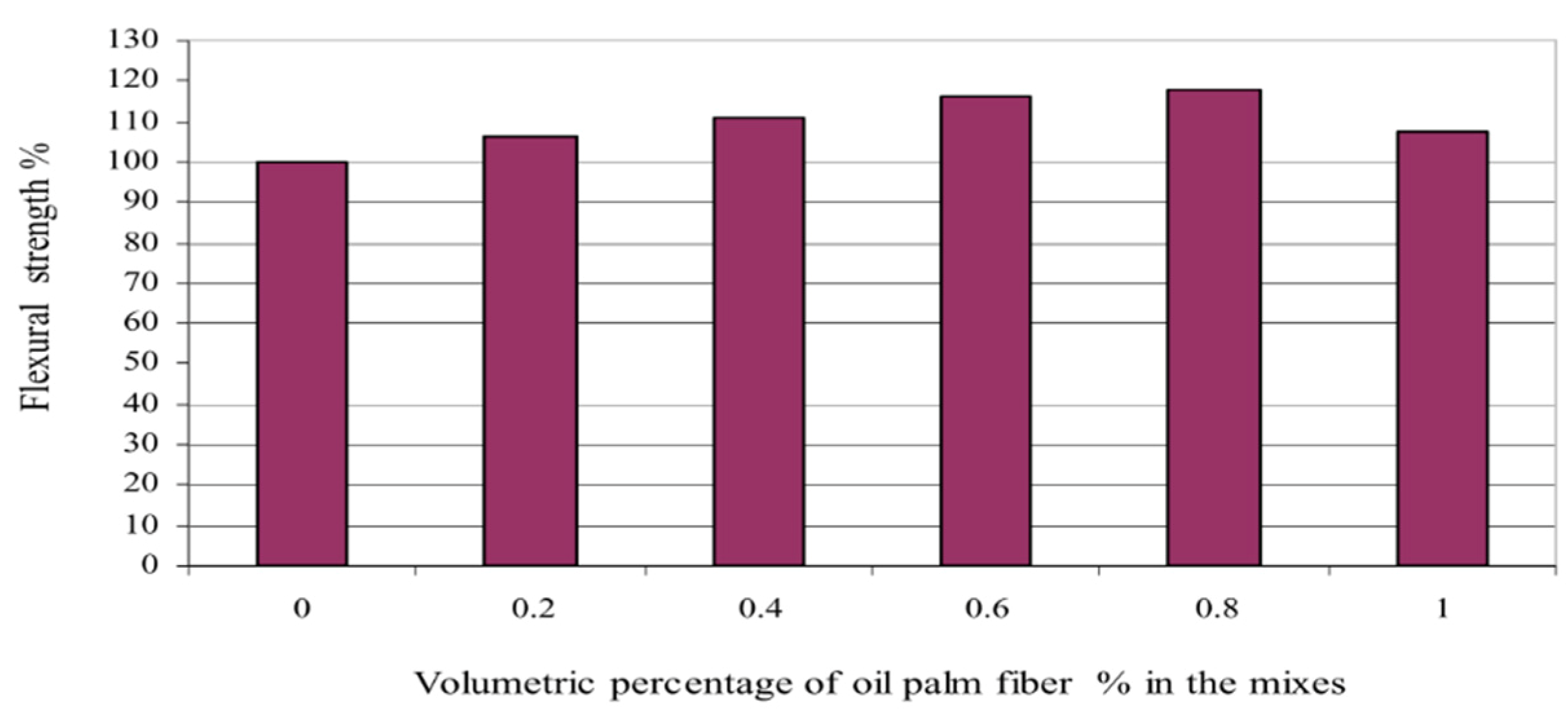
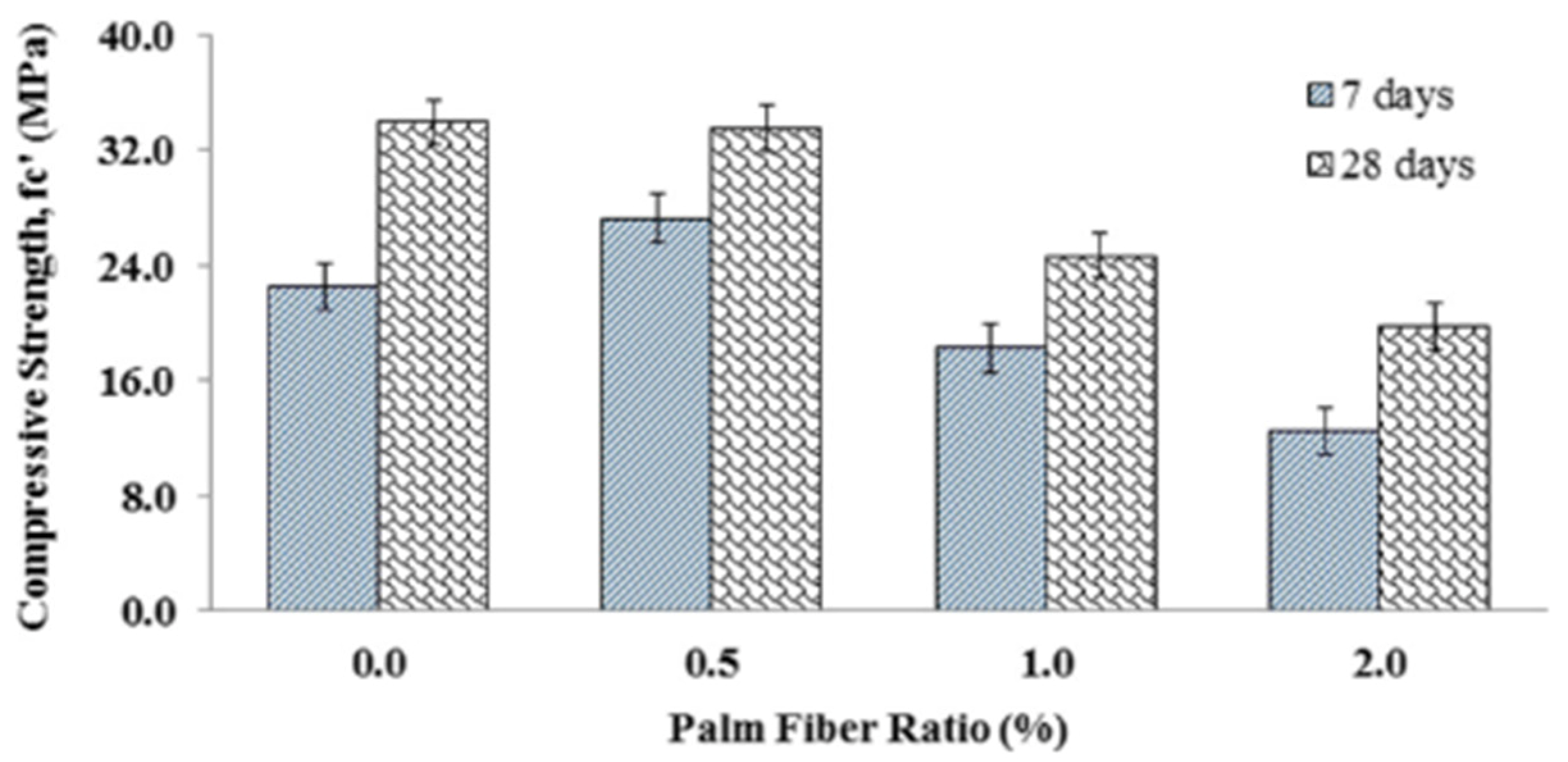
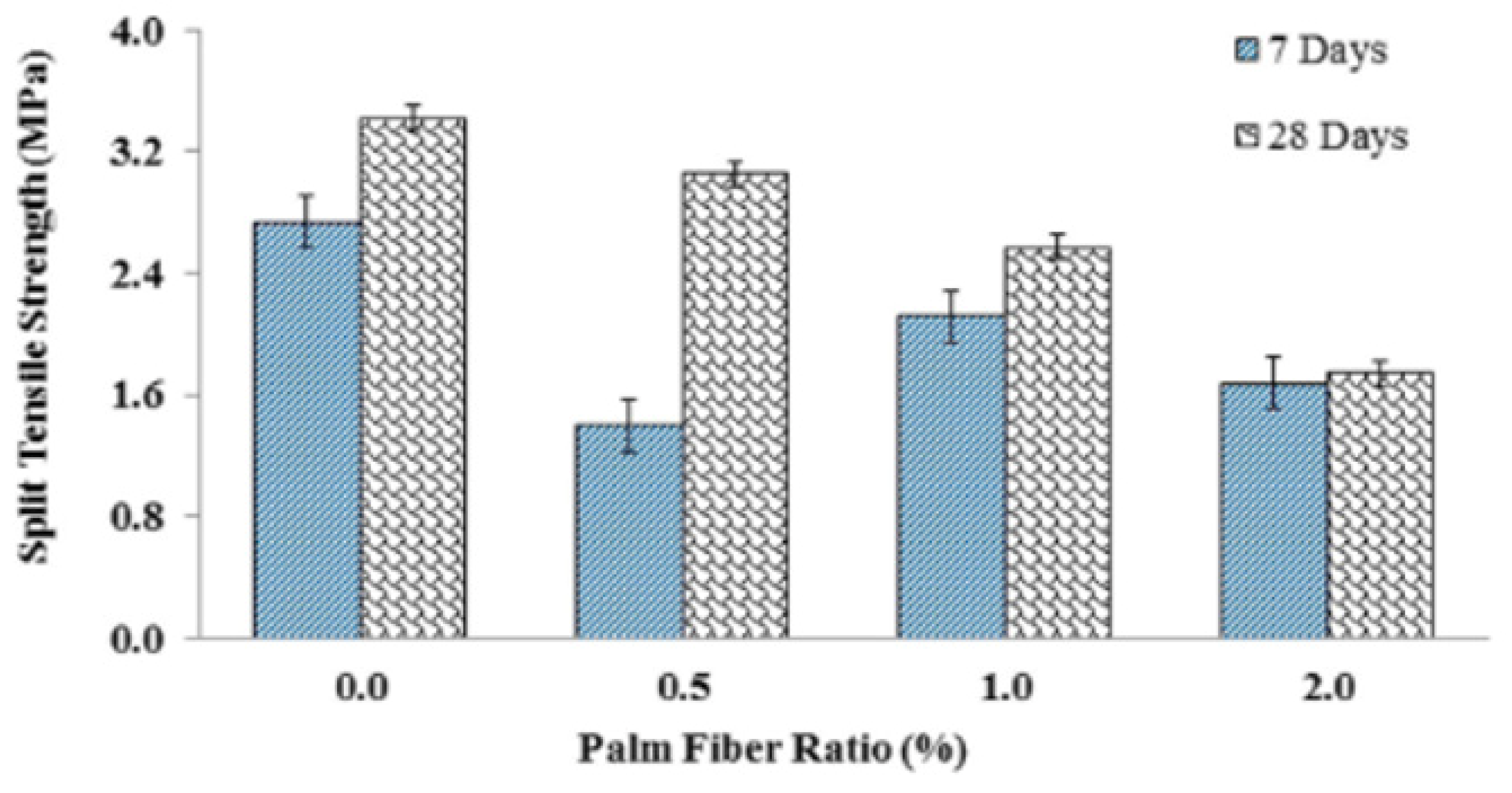
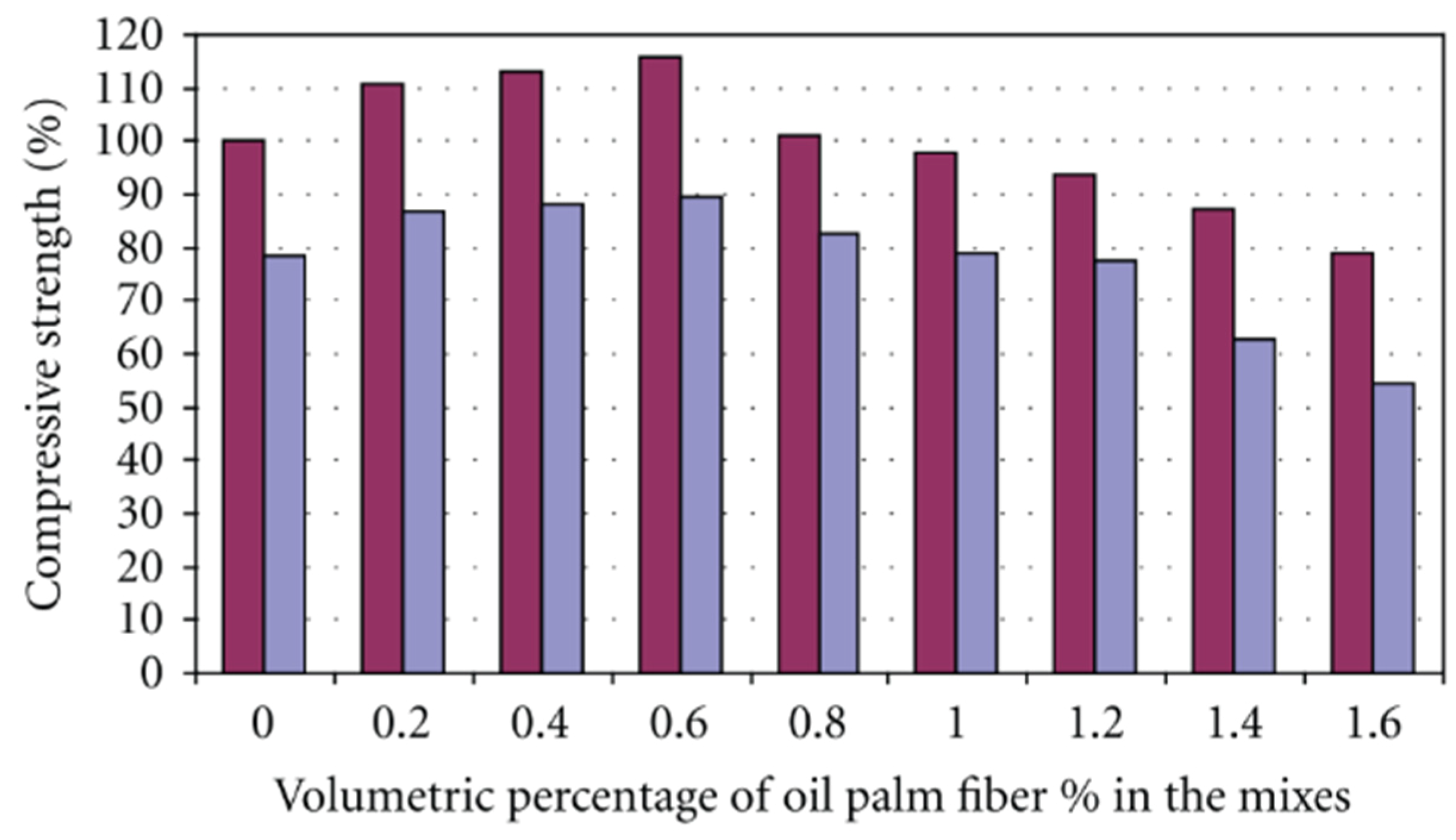

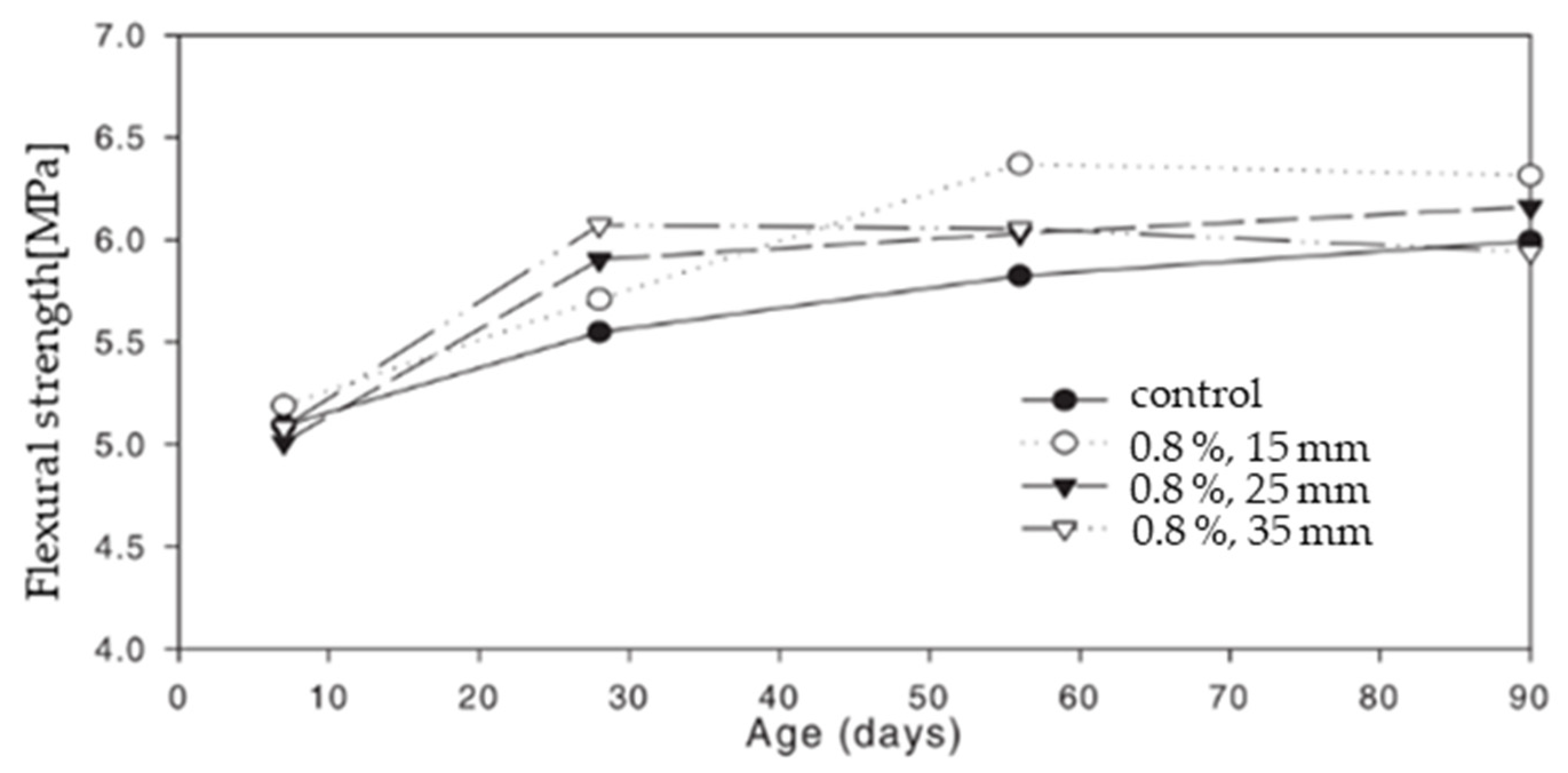
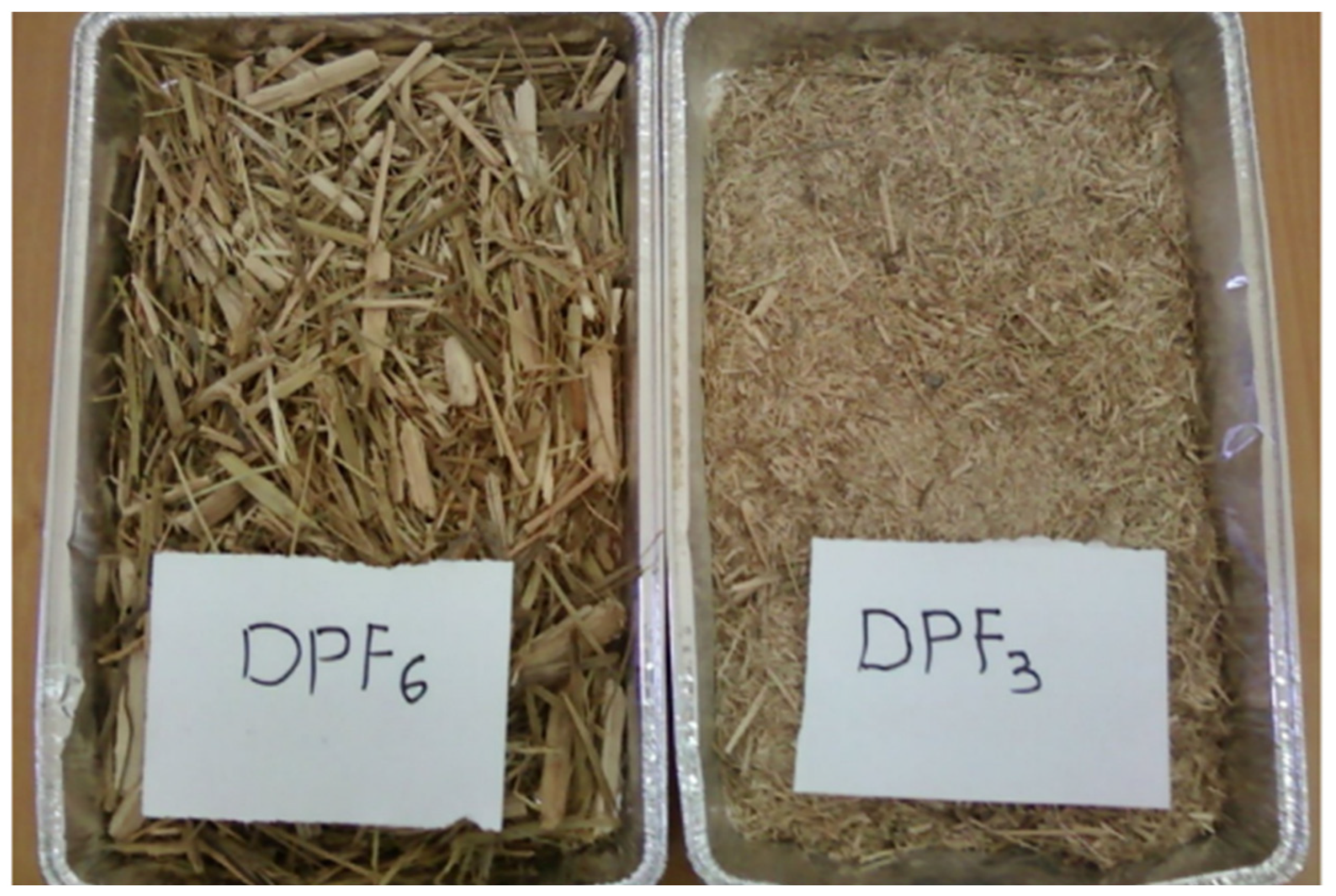
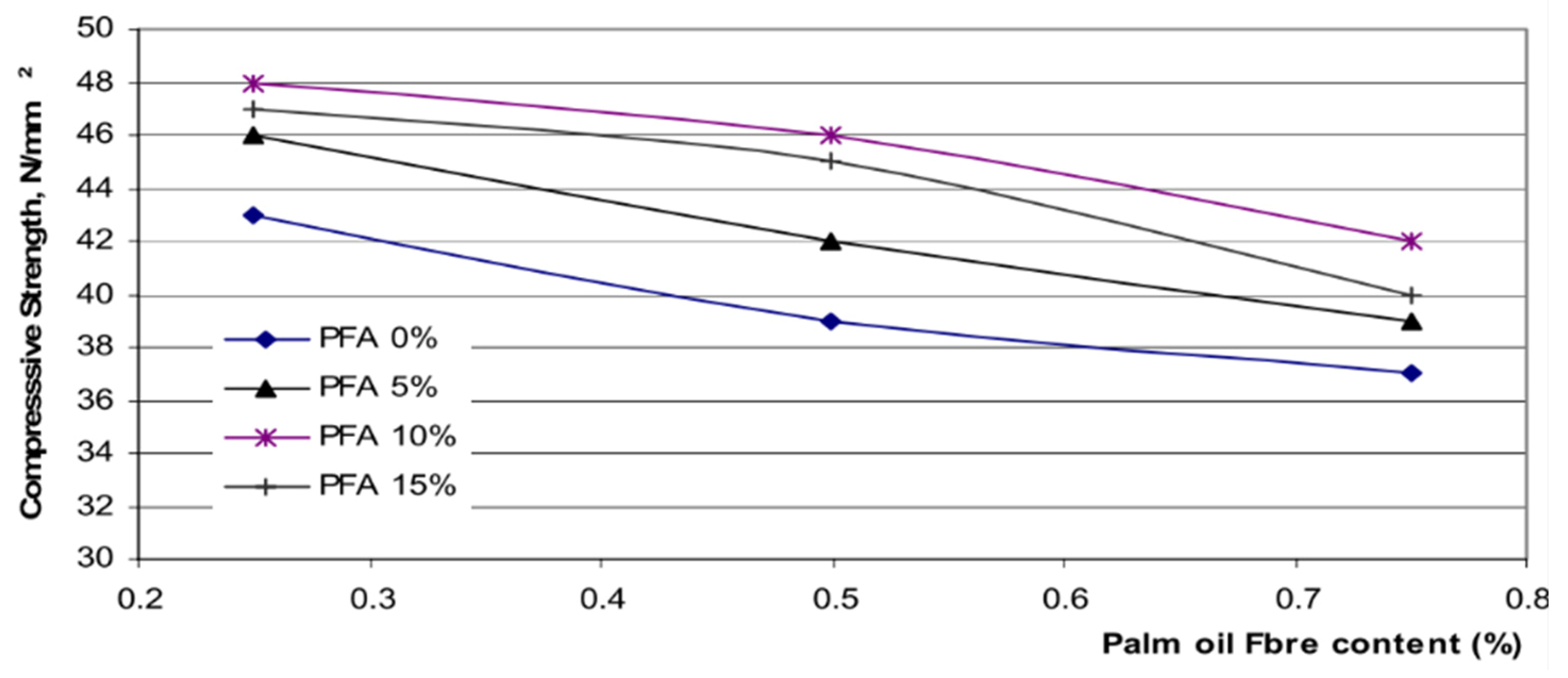



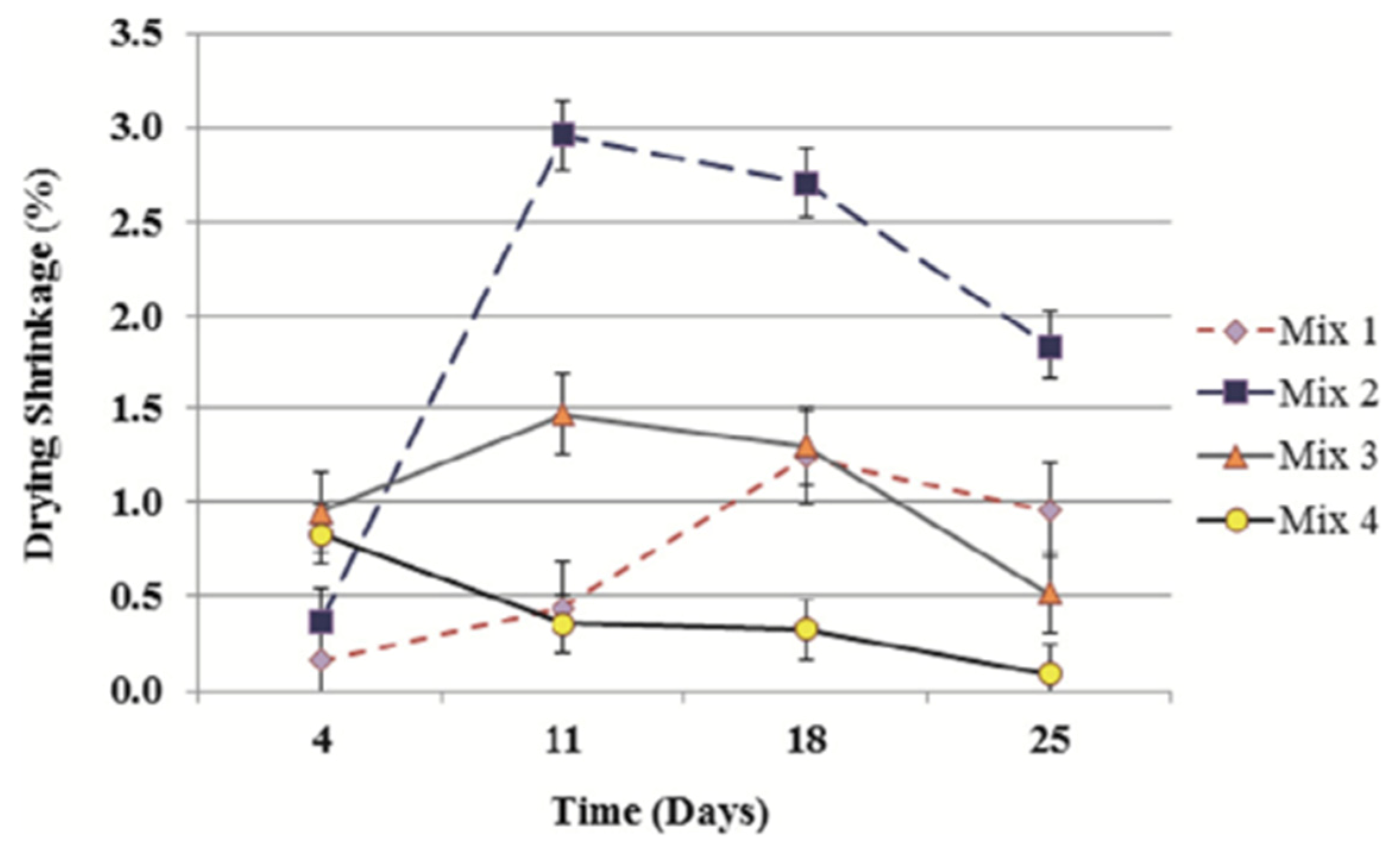

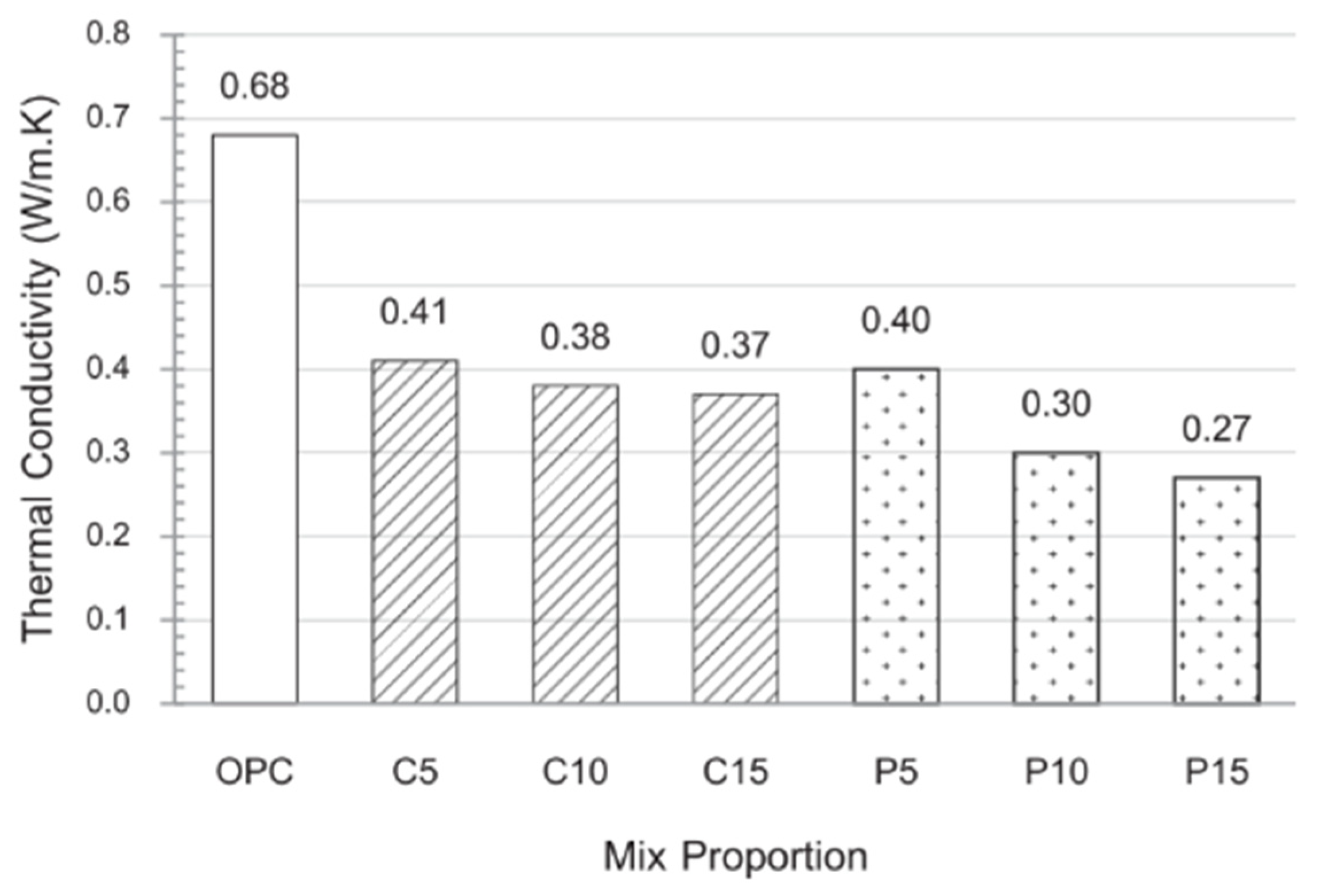
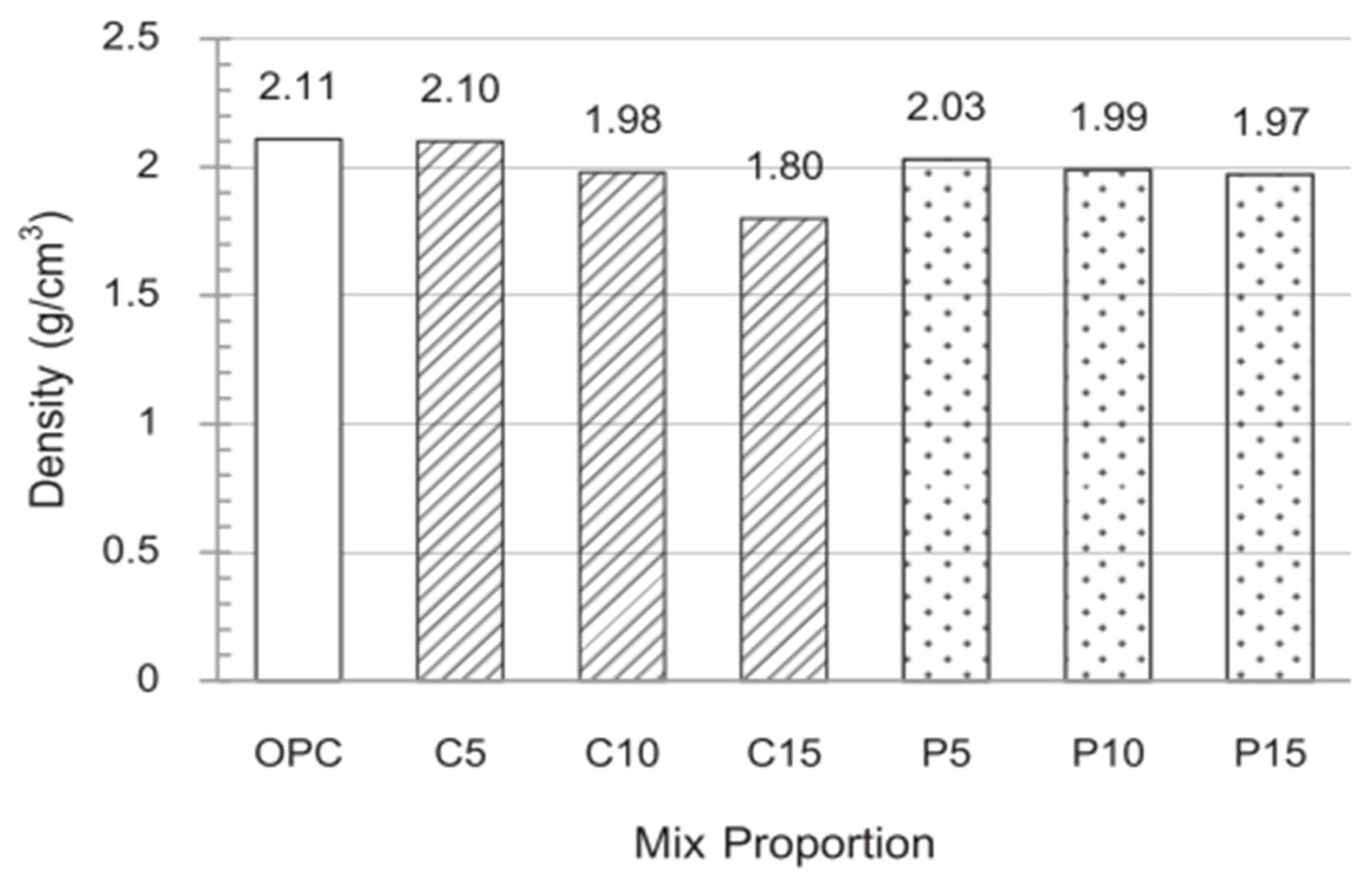
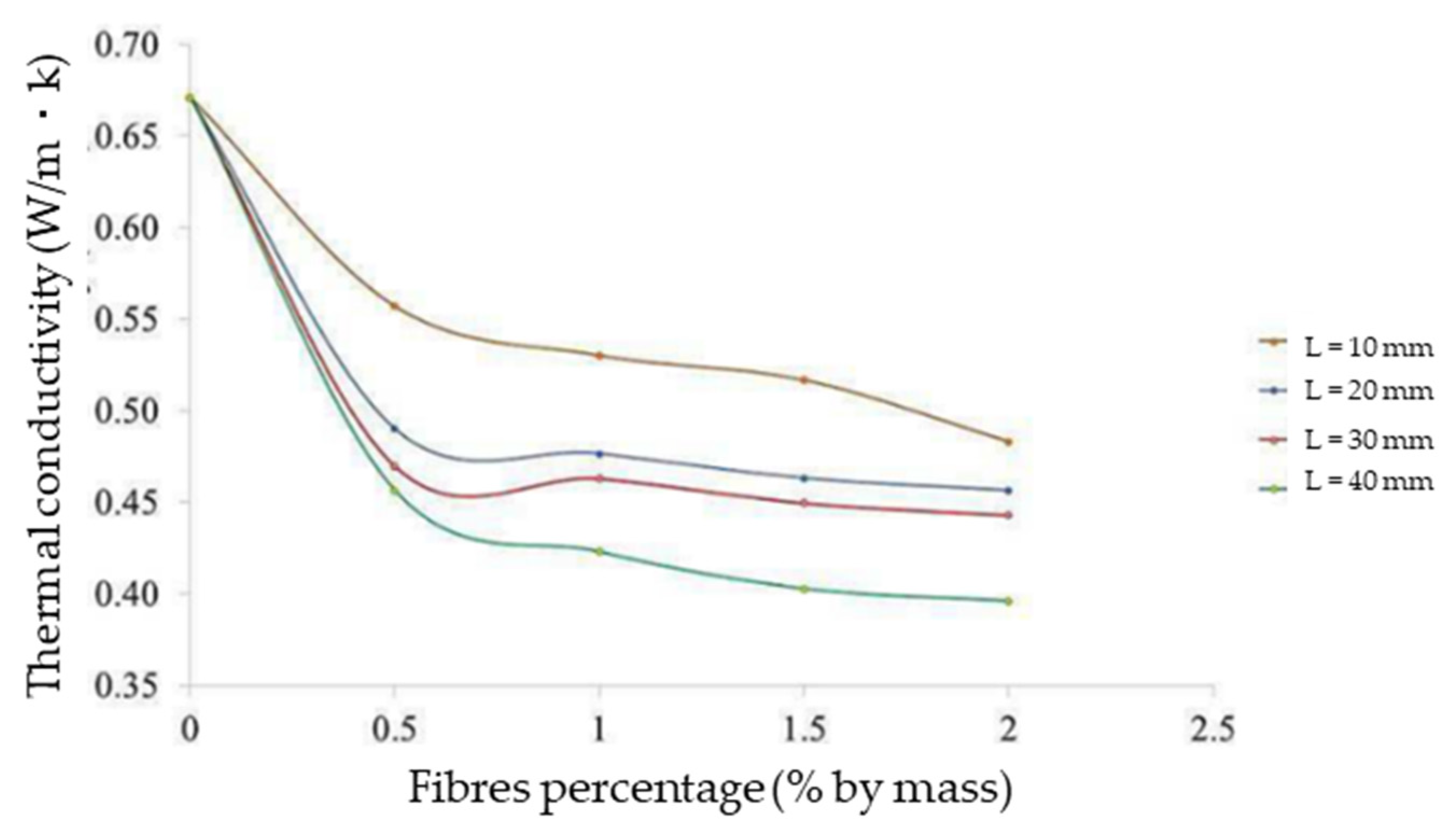
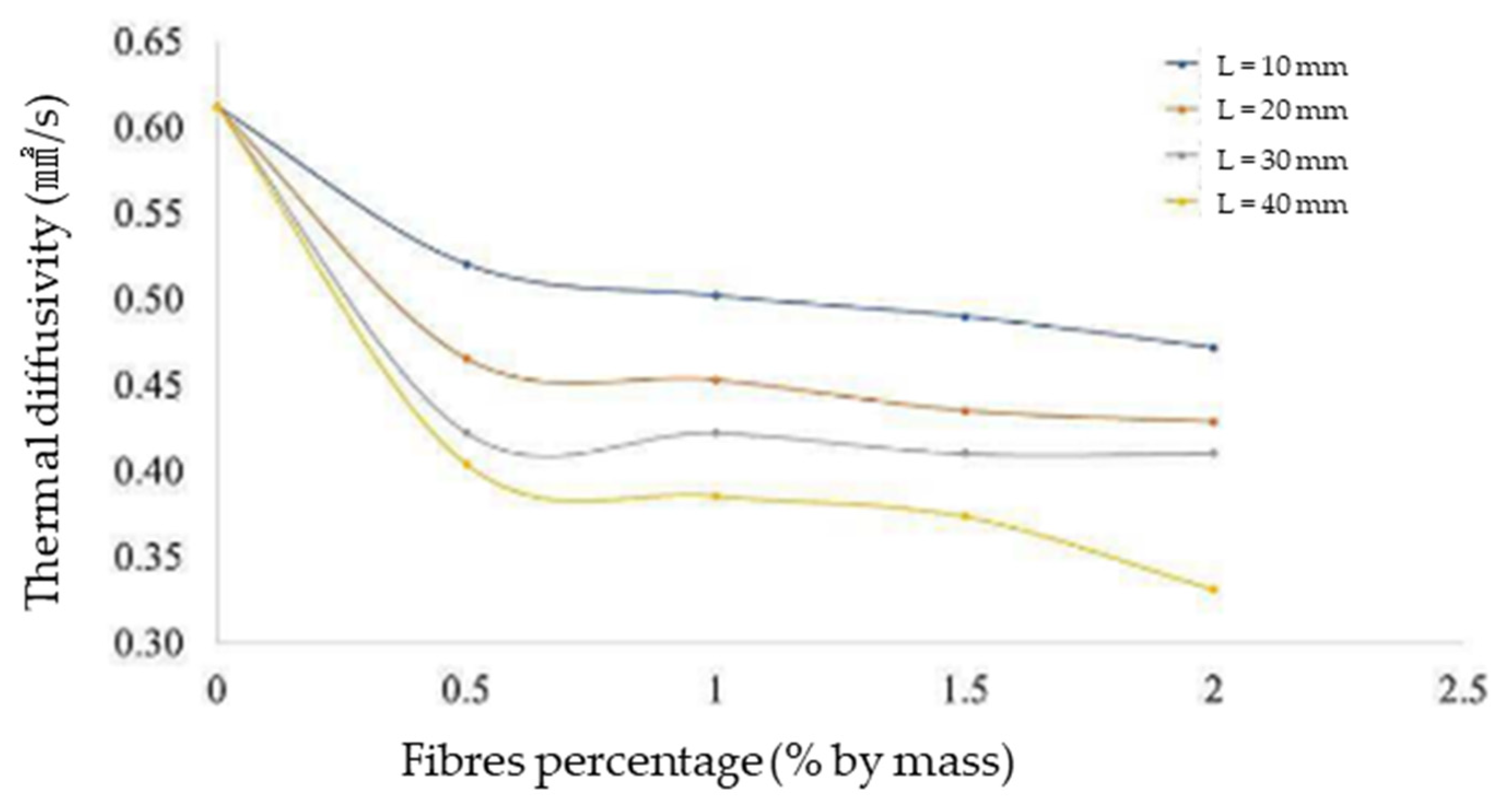
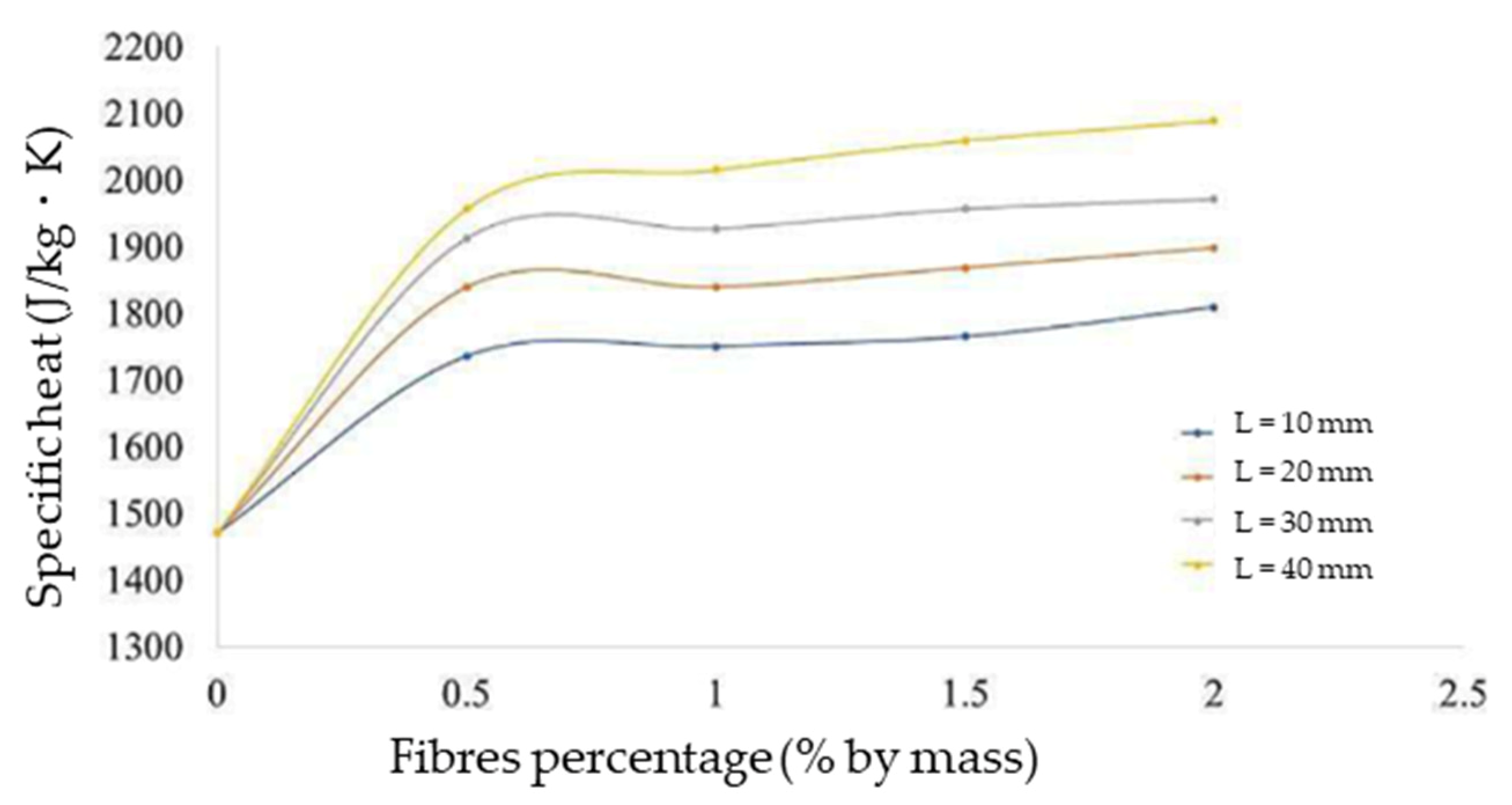
| Reference | Cellulose | Hemicellulose | Lignin | Pentosan | Ash | Silica |
|---|---|---|---|---|---|---|
| [36] | 33.2 | 31.1 | 20.5 | - | - | - |
| [33] | 43–60 | 11.6–21 | 27.7–45 | - | 3.9–8.1 | - |
| [34] | 35–47 | 28–15 | 20–31 | - | - | |
| [35] | - | - | 32.8 | - | 2.2 | - |
| Reference | Diameter (mm) | Length (mm) | Density | Tensile Strength (MPa) | Modulus of Elasticity (MPa) | Elongation at Break (%) | Water Absorption (%) |
|---|---|---|---|---|---|---|---|
| [20] | 0.25 | 1.41 | 77.82 | ||||
| [37] | 1.2 | 175 | 4000–6000 | 30 | |||
| [32] | 0.40–0.10 | 60–250 | 15–327 | 75 | |||
| [38] | 1.2 | 500 | |||||
| [39] | 0.32 | 20–30 | 22,400 | ||||
| [40] | 0.21 | 1.1–1.4 | 107 | 2800 | 37.7 | 93.8–161.0 |
| Reference | Cellulose | Hemicellulose | Lignin | Pentosan | Ash | Silica |
|---|---|---|---|---|---|---|
| [41] | 49.6 | 18 | 21.1 | 17.8 | 2 | - |
| [42] | - | - | 29.8 | 14.4 | 2.65 | - |
| [23] | 42.7–65 | 17.1–33.5 | 13.2–25.31 | 17.8–20.3 | 1.3–6.04 | 1.8 |
| Reference | Diameter (mm) | Length (mm) | Density | Tensile Strength (MPa) | Module of Elasticity (MPa) | Elongation at Break (%) | Water Absorption (%) |
|---|---|---|---|---|---|---|---|
| [44] | 0.2–0.7 | 40 | - | - | - | - | 60 |
| [43] | 0.021 | 30 | - | 21.2 | - | 1.24 | 0.6 |
| [46] | - | - | 1.2 | 300–600 | - | - | - |
| [25] | 0.3–0.5 | - | - | - | 2500–3000 | 2–5 | 0.5 |
| [23] | - | - | 0.7–1.51 | 25–550 | 500–9000 | 4–18 | - |
| [22] | - | - | 1.10 | 300–600 | 15,000–32,000 | - | - |
| Type of Pre-Treatment | ||
|---|---|---|
| Alkaline | Percentage of solution | 2%, 4%, 6% and 10% (NaOH) |
| Soaking time | 30 min, 2 h, 6 h, 12 h, 24 h and 48 h | |
| Silane | Percentage of solution | 1% and 3% (triethoxyvinylsilane) |
| Soaking time | 1 h, 2 h, 4 h, 8 h, 24 h and 48 h | |
| Hot water | Temperature | 100 °C |
| Soaking time | 15 min, 30 min, 1 h and 2 h |
| Description of Workability | Slump (mm) |
|---|---|
| No slump | 0 |
| Very low | 5–10 |
| Low | 15–30 |
| Medium | 35–75 |
| High | 80–155 |
| Very high | 160 to collapse |
| Fibre Content | Initial (h) | Finish (h) |
|---|---|---|
| 0.0% | 3.00 | 4.00 |
| 0.5% | 3.15 | 3.55 |
| 1.0% | 4.25 | 5.00 |
| 2.0% | 2.20 | 2.45 |
| Type of Strength | Materials Ages | 0% | 3% | 4% | 5% |
|---|---|---|---|---|---|
| Compressive strength (MPa) | 7 days | 18.23 | 19.53 | 13 | 8.1 |
| 28 days | 22.27 | 24.1 | 21.43 | 15.13 | |
| Splitting tensile Strength (MPa) | 7 days | 2.5 | 2.6 | 2.3 | 2.22 |
| 28 days | 3.48 | 3.56 | 2.95 | 2.9 |
| Volume of Fibre% | Compressive Strength (MPa) | Flexural Strength (MPa) | Split Tensile Strength (MPa) |
|---|---|---|---|
| 0 | 30.5 | 27.2 | 1.6 |
| 1 | 39.6 | 32.2 | 2.0 |
| 2 | 27.3 | 22.3 | 1.5 |
| 3 | 22.3 | 23.8 | 1.7 |
| Reference | Mechanical Properties (MPa) | Coconut Fibre Content (%) | ||||||||||||||
|---|---|---|---|---|---|---|---|---|---|---|---|---|---|---|---|---|
| 0 | 0.5 | 0.6 | 0.75 | 0.8 | 1.0 | 2.0 | 2.5 | 3.0 | 4.0 | 5.0 | 6.0 | 9.0 | 12 | 15 | ||
| [49] | Compressive strength | 41.19 | - | - | - | - | - | - | - | 33.73 | - | - | 38.54 | 43.84 | 27.05 | 26.04 |
| [28] | Compressive strength | 65 | - | - | - | - | 50 | - | 45 | - | 35 | - | - | - | - | - |
| [51] | Compressive strength | 22.7 | - | - | - | - | - | - | - | 24.1 | 21.43 | 15.13 | - | - | - | - |
| Split tensile strength | 3.48 | - | - | - | - | - | - | - | 3.56 | 2.95 | 2.9 | - | - | - | - | |
| [52] | Compressive strength | 40.7 | - | 29.8 | - | 27.9 | - | - | - | - | - | - | - | - | - | - |
| Flexural strength | 4.3 | - | 3.9 | - | 3.8 | - | - | - | - | - | - | - | - | - | - | |
| [53] | Compressive strength | - | 2.95 | - | 2.6 | - | - | - | - | - | - | - | - | - | - | - |
| [54] | Compressive strength | 31.7 | - | - | - | - | - | 39.05 | - | 38.3 | - | 30.34 | - | - | - | - |
| Reference | Mechanical Properties (MPa) | Palm Oil Fibre Content (%) | ||||||||||||||||||||
|---|---|---|---|---|---|---|---|---|---|---|---|---|---|---|---|---|---|---|---|---|---|---|
| 0 | 0.2 | 0.25 | 0.4 | 0.5 | 0.6 | 0.75 | 0.8 | 1.0 | 1.2 | 1.4 | 1.5 | 1.6 | 2.0 | 3.0 | 4.0 | 5.0 | 6.0 | 8.0 | 10 | 15 | ||
| [55] | Compressive strength | 5.2 | - | - | - | - | - | - | - | - | - | - | - | - | 3.2 | - | 1.8 | - | 1.6 | 1.2 | 1.0 | - |
| [42] | Compressive strength | 46.8 | - | - | - | - | - | - | - | - | - | - | - | - | - | - | - | 36.9 | - | - | 34.7 | 28.3 |
| [1] | Compressive strength | 42.9 | - | - | - | 41.6 | - | - | - | 40.5 | - | - | - | - | 33.7 | 34.8 | 29.1 | - | - | - | - | - |
| Flexural strength | 3.88 | - | - | - | 3.5 | - | - | - | 3.68 | - | - | - | - | 3.57 | 3.55 | 3.95 | - | - | - | - | - | |
| Split tensile strength | 3.33 | - | - | - | 3.45 | - | - | - | 3.37 | - | - | 3.15 | - | 3.05 | 2.89 | 2.94 | - | - | - | - | - | |
| [45] | Split tensile strength | 1.6 | - | - | - | - | - | - | - | 2.5 | - | - | - | - | 1.5 | 1.8 | 1.5 | - | - | - | - | - |
| [56] | Compressive strength | 47.3 | 49.5 (5 kg/m3 of fibre) | - | 52.8 (10 kg/m3 of fibre) | - | 55.1 (15 kg/m3 of fibre) | - | - | - | - | - | - | - | - | - | - | - | - | - | - | - |
| [57] | Compressive strength | 23 | 24.15 | - | 24.38 | - | 24.84 | - | 25.76 | 22.77 | - | - | - | - | - | - | - | - | - | - | - | - |
| Flexural strength | 4.15 | 4.39 | - | 4.6 | - | 4.8 | - | 4.93 | 4.52 | - | - | - | - | - | - | - | - | - | -- | |||
| [24] | Compressive strength | 32.2 | - | - | - | 32.1 | - | - | - | 24.0 | - | - | - | - | 16.4 | - | - | - | - | - | - | - |
| Split tensile | 3.4 | - | - | - | 3.1 | - | - | - | 2.4 | - | - | - | - | 1.6 | - | - | - | - | - | - | - | |
| [46] | Compressive strength | 15.15 | - | - | - | - | - | - | - | - | - | - | - | - | 38.6 | - | - | - | 16.02 | - | - | - |
| [43] | Compressive strength | 53 | 58.3 | - | 59.36 | - | 60.95 | - | 53.53 | 51.94 | 49.29 | 46.64 | - | 42.4 | - | - | - | - | - | - | - | - |
| Flexural strength | 7.6 | 7.75 | - | 7.98 | - | 8.43 | - | 7.14 | 6.68 | 6.46 | 6.23 | - | 5.7 | - | - | - | - | - | - | - | - | |
| [25] | Compressive strength | 53.6 | 57.4 (15 mm) 56.1 (25 mm) 60.7 (35 mm) | - | 54.7 (15 mm) 53.6 (25 mm) 46.7 (35 mm) | - | 51.4 (15 mm) 60.6 (25 mm) 54.1 (35 mm) | - | 48.0 (15 mm) 55.2 (25 mm) 46.1 (35 mm) | - | - | - | - | - | - | - | - | - | - | - | - | - |
| Flexural strength | 5.55 | 6.074 (15 mm) 5.62 (25 mm) 5.60 (35 mm) | - | 5.48 (15 mm) 5.63 (25 mm) 5.92 (35 mm) | - | 5.81 (15 mm) 5.55 (25 mm) 5.8 (35 mm) | - | 5.71 (15 mm) 5.9 (25 mm) 6.07 (35 mm) | - | - | - | - | - | - | - | - | - | - | - | - | - | |
| [58] | Compressive strength | 34.9 | - | - | - | - | - | - | - | - | - | -- | - | - | - | - | 32.07 (MDP6) 32.1 (MDP3) 29.6 (MIX) | - | - | - | - | |
| [22] | Compressive strength | 30.5 | - | - | - | - | - | - | - | 39.6 | - | - | - | - | 27.3 | 22.3 | - | - | - | - | - | - |
| Flexural | 27.2 | - | - | - | - | - | - | - | 32.2 | - | - | - | - | 22.3 | 23.8 | - | - | - | - | - | - | |
| Split tensile strength | 1.6 | - | - | - | - | - | - | - | 2.0 | - | - | - | - | 1.5 | 1.7 | - | - | - | - | - | - | |
| [44] | Compressive strength | - | - | 43 | - | 39 | - | 37 | - | - | - | - | - | - | - | - | - | - | - | - | - | - |
| Split tensile strength | - | - | 4.1 | - | 4.6 | - | 4.8 | - | - | - | - | - | - | - | - | - | - | - | - | - | - | |
Publisher’s Note: MDPI stays neutral with regard to jurisdictional claims in published maps and institutional affiliations. |
© 2021 by the authors. Licensee MDPI, Basel, Switzerland. This article is an open access article distributed under the terms and conditions of the Creative Commons Attribution (CC BY) license (https://creativecommons.org/licenses/by/4.0/).
Share and Cite
Futami, E.; Shafigh, P.; Katman, H.Y.B.; Ibrahim, Z. Recent Progress in the Application of Coconut and Palm Oil Fibres in Cement-Based Materials. Sustainability 2021, 13, 12865. https://doi.org/10.3390/su132212865
Futami E, Shafigh P, Katman HYB, Ibrahim Z. Recent Progress in the Application of Coconut and Palm Oil Fibres in Cement-Based Materials. Sustainability. 2021; 13(22):12865. https://doi.org/10.3390/su132212865
Chicago/Turabian StyleFutami, Erika, Payam Shafigh, Herda Yati Binti Katman, and Zainah Ibrahim. 2021. "Recent Progress in the Application of Coconut and Palm Oil Fibres in Cement-Based Materials" Sustainability 13, no. 22: 12865. https://doi.org/10.3390/su132212865
APA StyleFutami, E., Shafigh, P., Katman, H. Y. B., & Ibrahim, Z. (2021). Recent Progress in the Application of Coconut and Palm Oil Fibres in Cement-Based Materials. Sustainability, 13(22), 12865. https://doi.org/10.3390/su132212865






